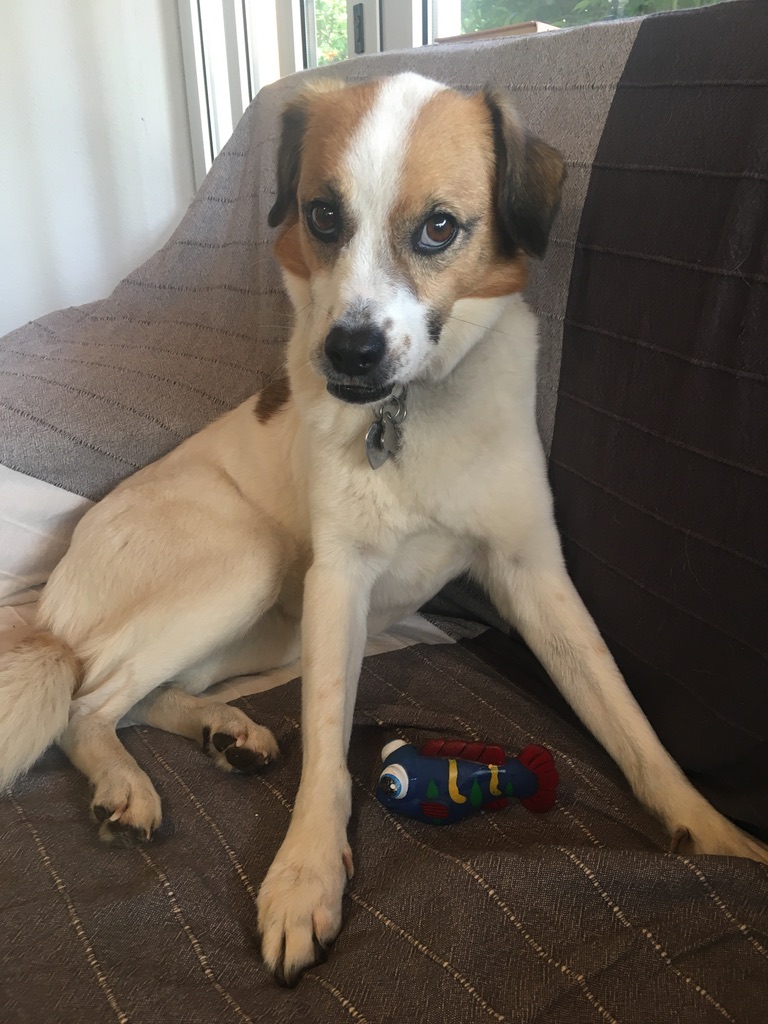Back to BEARS: Surveying the Most Diachronic Islet (Praso)
After a series of minor miracles (and careful planning), the Bays of East Attica Regional Survey was able to secure funding and permits for a 2021 field season. Our season will be shorter this year (just four weeks), and many of our key team members were unable to travel to Greece due to the pandemic. On the blog this month, you’ll hear some more about COVID, including our team’s mitigation and safety measures and how the pandemic has changed the way we think about archaeology. We’re also planning some posts that are more typical of a good old field archaeology blog (including a highly anticipated archaeological confessional with our fearless leader, Sarah C. Murray). But, let’s not rest on our blogging laurels; we just finished our first week of field work and there is much to report!


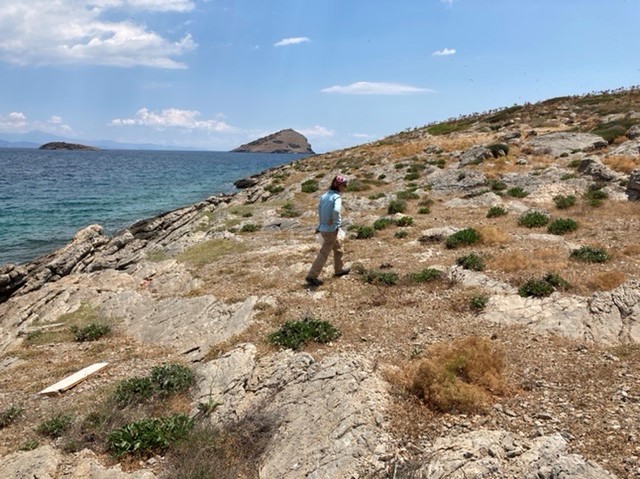
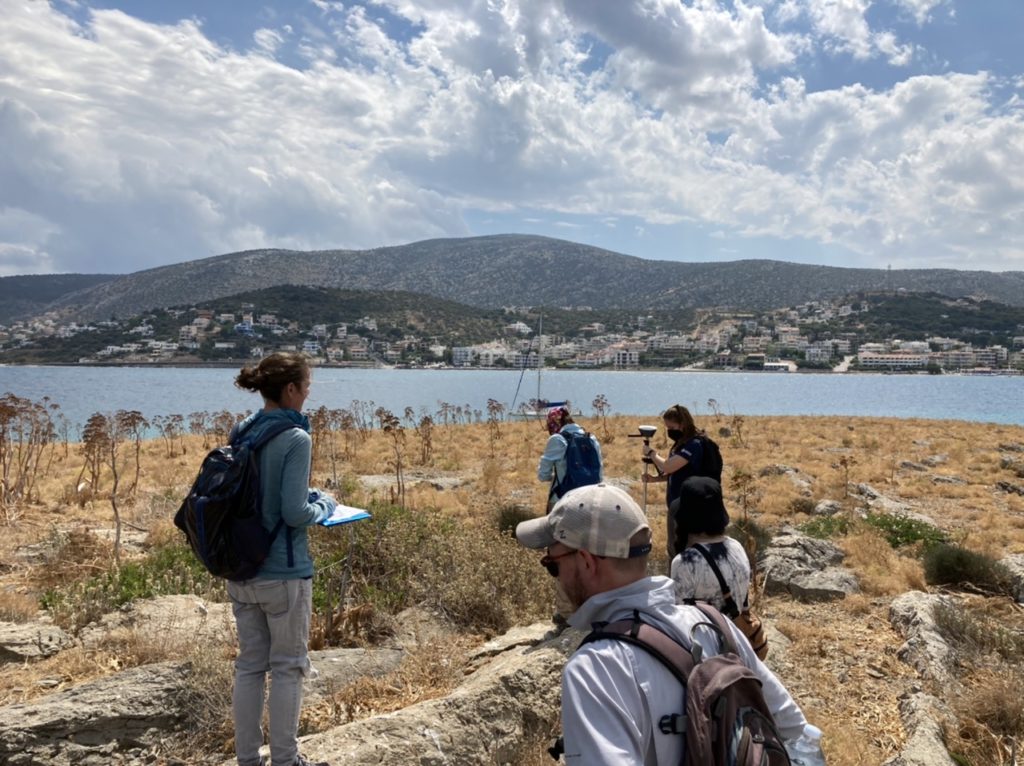
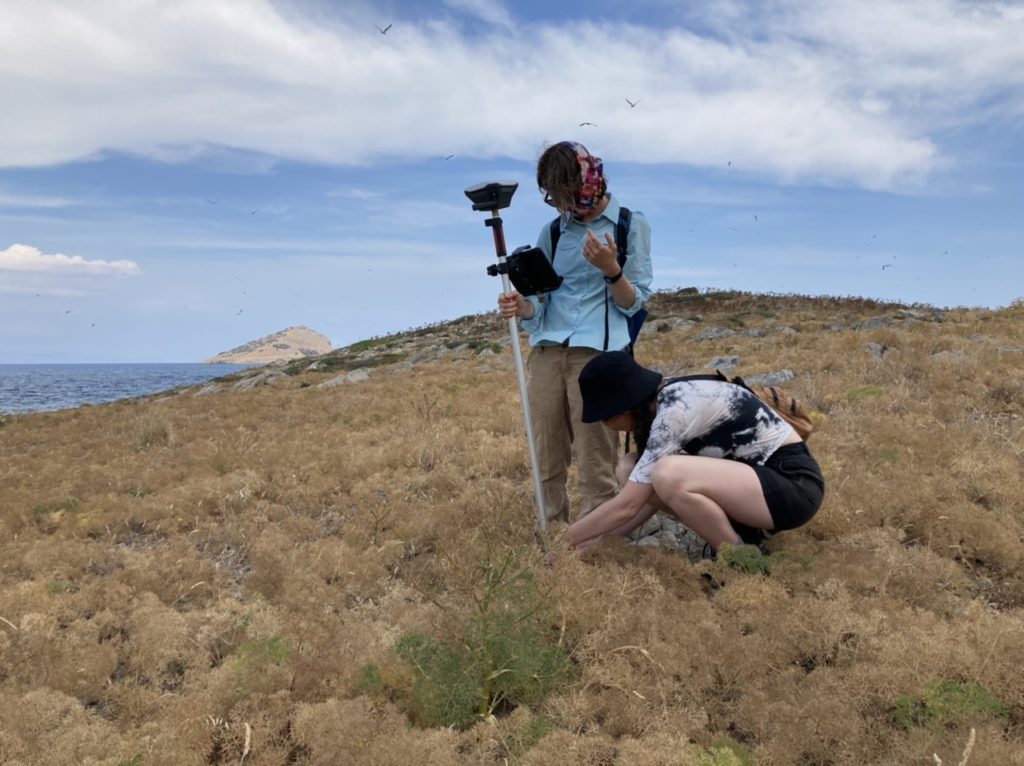
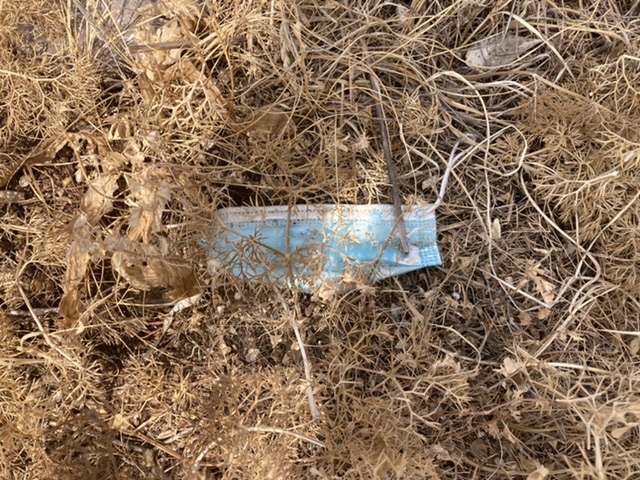
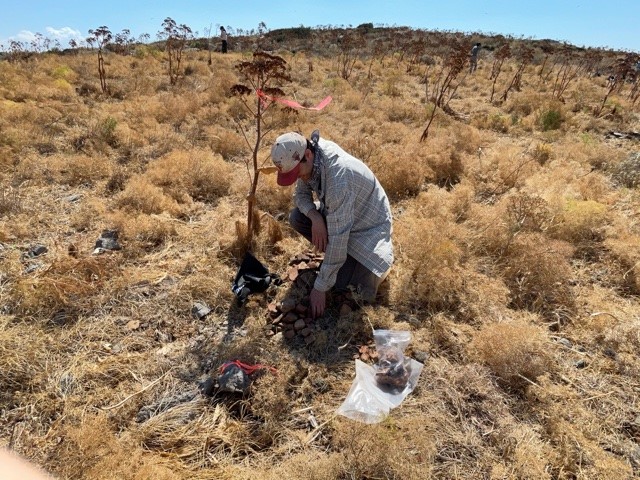
What’s more, the Praso assemblage has shown a very different functional profile than its sibling island of Ratfis. The team has collected several ceramic wasters, slag, and pieces of ore, suggesting that the fires of industry may have roared at various points in Praso’s history. Other finds have included glass, figurines, obsidian and chert lithics, and, of course, abundant combed amphora body sherds. A few days of field collection have only begun to reveal the many secrets of this small and deceptively complex islet.
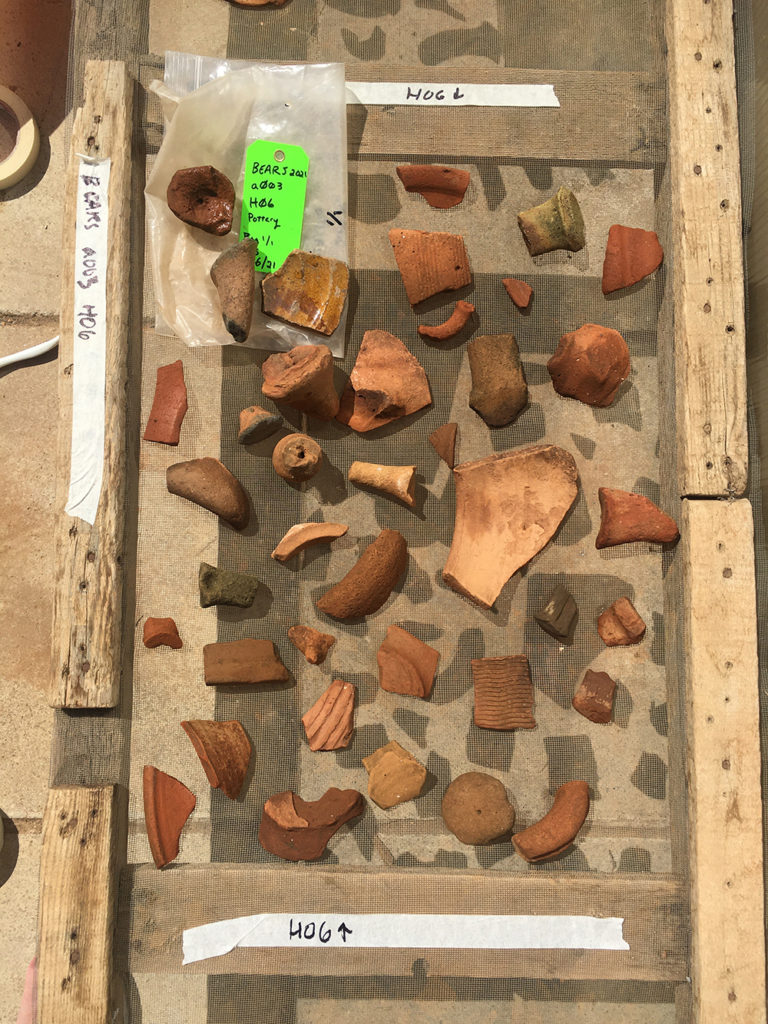
BEARS 2019 Report Published

The preliminary report of results from the 2019 field season has been published, in the most recent issue (17.2) of the journal Mouseion. The report provides general information about the project’s research goals, a description of our methods and fieldwork, and some early-stage analysis of lithics, Late Bronze Age pottery, and roof tiles, to the extent that we were able to study these materials in 2019. The report can be accessed here, or through Project Muse for those with access through an academic institution.
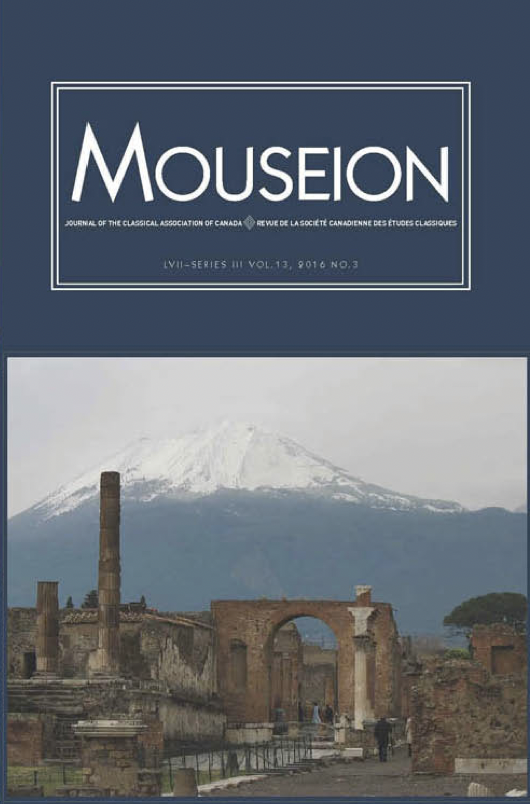
BEARS-adjacent research on the BBC
Perhaps of interest: research on the role of women in Greek pottery production during the Early Iron Age by three BEARS team members (Murray, Chorghay, and MacPherson) will be featured on a BBC radio program called The Conversation tomorrow.
The show will air on the BBC World Service radio March 1st (Monday) at 9:30, 13:30, 21:30 and 23:30 GMT. A podcast will be available online here.
Canadian winter comes to Raftis
Alex Clapp, renowned Balkan journalist, Athenian resident, and longtime accomplice/friend of BEARS, sent me this photo of Raftis this week with a dusting of snow, which might be of interest to fans of all things Porto Rafti. I dunno how often this happens, but it is comforting to know that even though we in Canada can’t visit Greece right now, at least the Canadian winter made it over for a little R&R on the beaches of eastern Attica.
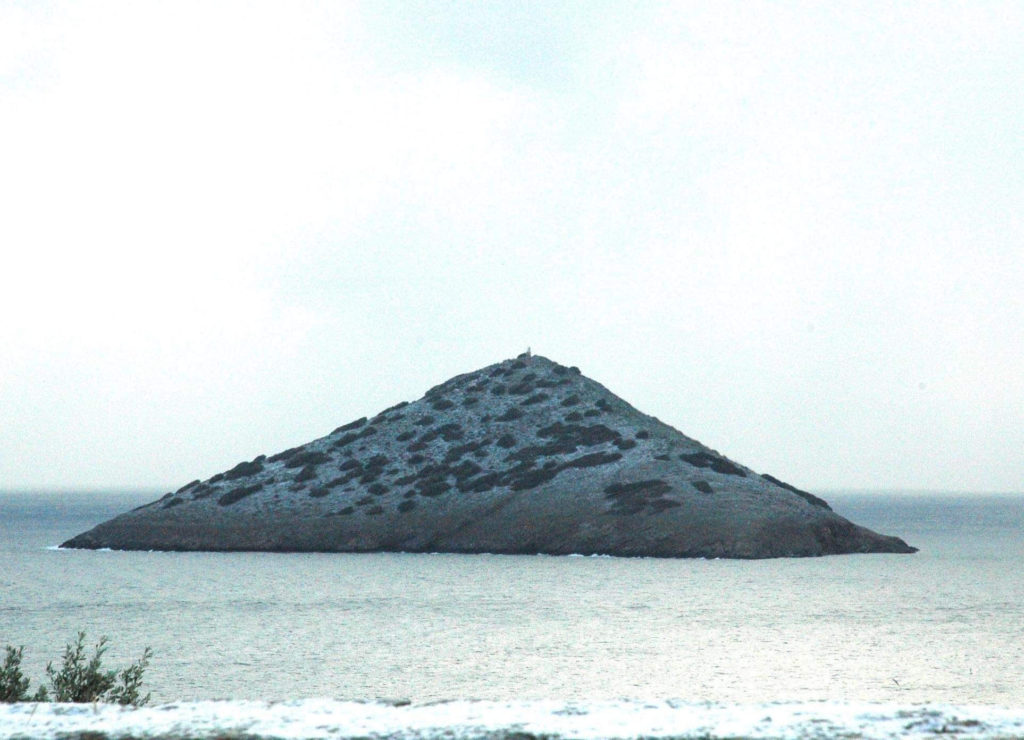
I’m pretty sure Athens got more snow than Toronto this week, which makes me quite envious! Here the winter has mostly just been cold, grey, and kinda tedious. The view from several months into a city-wide lockdown: something else we have in common with our friends in Athens!
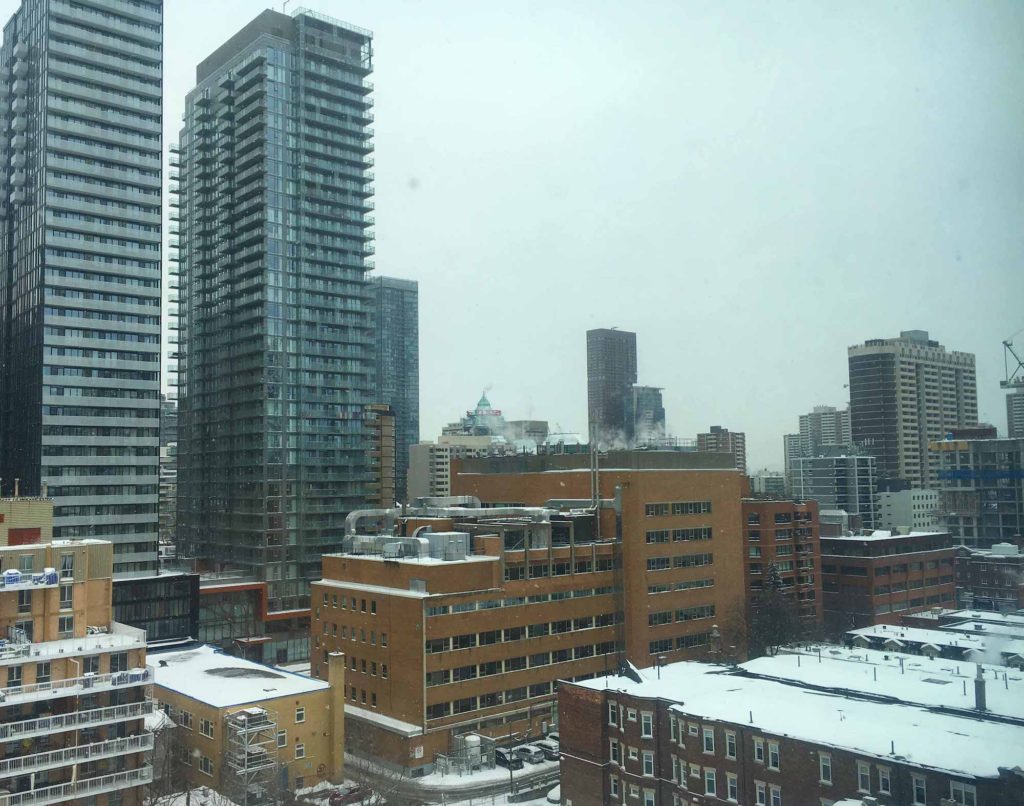
Community Archaeology and BEARS: Where to Start?
The BEARS blog is very excited to share this post about the potential for developing some aspects of community-engaged archaeology in the context of the BEARS project, written by Joseph (aka Joey) Frankl.
When the blog was founded in early 2020, the intention was for it to serve as a medium through which our small project community could exchange/share ideas, thoughts, and memories about BEARS over the spring and summer, since it had become clear that we probably wouldn’t get to see each other in the field for some time. As it turns out, most people were far too busy with all of the chaos of pandemic life to put together contributions, which is totally understandable. We do hope that as life returns to normal, the project matures, and our many talented team members feel increasing ownership over the direction and goals of our work in East Attica, the sharing of ideas and in this space will likewise grow!
With that in mind, it’s encouraging to have our first bona fide team member contribution to the blog since way back in early June, 2020! And what a stellar piece it is – a sophisticated and thought-provoking consideration of what community-engaged archaeology in Greece and Porto Rafti might or should look like, and the many reasons that Classical archaeology has not traditionally been at the forefront of this sort of work.
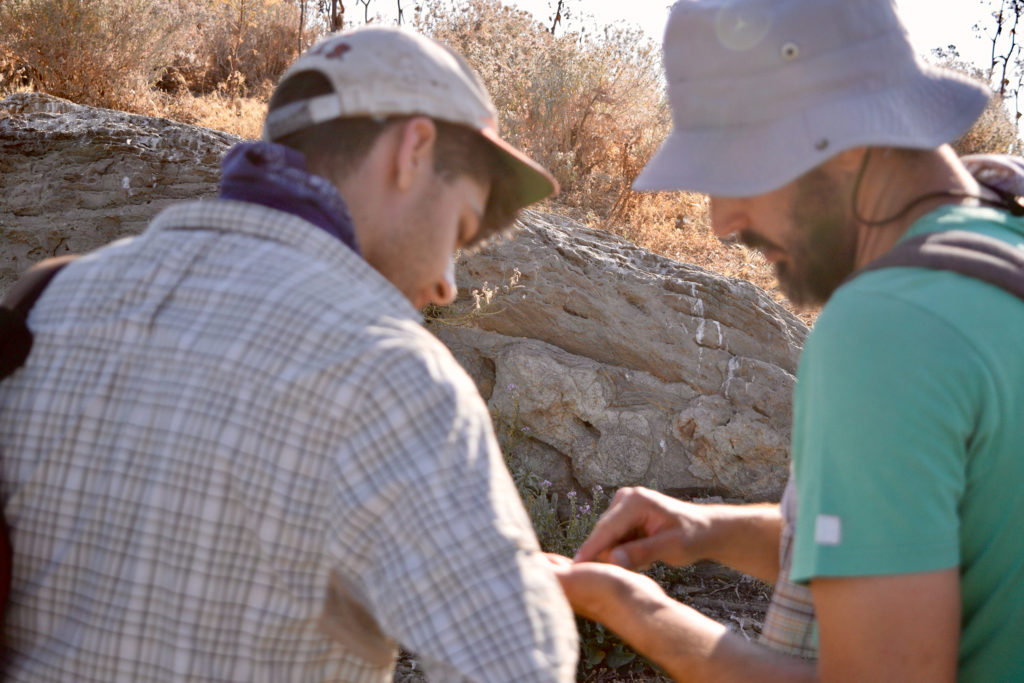
This fall, I, along with several of my University of Michigan colleagues, organized a roundtable session about community-based archaeology. Community-based archaeology – or community-engaged/community archaeology – has been variously and widely defined, but is typically understood as archaeological practices that integrate community members with external research teams in the production, preservation, and dissemination of archaeological knowledge. As my co-organizers and I conceived the session, four archaeologists (working in different disciplinary and geographic contexts) would create a dialogue for our archaeological community concerning best practices of community archaeology and its future in the discipline of archaeology. Despite the technical difficulties of a remote format, the roundtable was a success! It’s clear that there is some really interesting work happening across the globe, work that is seriously attempting to make archaeology a more just and ethical discipline by integrating different types of stakeholders in the process of understanding of the past.
It was also painfully obvious how such practices seem absent from Classical Archaeology. This is not to say community-based archaeology does not exist in Mediterranean contexts. There are many good examples. But, generally speaking, community-based practices are simply not embedded in our disciplinary framework. (Do job searches in Classical Archaeology ask for community-based experience? Does the AIA annual meeting regularly include sessions dealing with the subject?) The reasons for the absence of community-engaged practices in Classical archaeology are complex and manifold. Classics and Classical Archaeology have tended to be slow on the uptake of critical, reflexive practices associated with post-colonialism, which have dictated disciplinary trends in the social sciences and humanities during the last several decades. Classical Archaeologists working abroad are also often associated with foreign research institutes that are unambiguously the vestiges, or contemporary products, of Northern European and American imperialism. Pursuing archaeology abroad was part of a larger project of Western knowledge production centered upon creating a history of European superiority. While foreign schools are increasingly working in collaboration with local archaeologists and there has been new success in community involvement, their institutional purpose is not oriented towards community engagement.
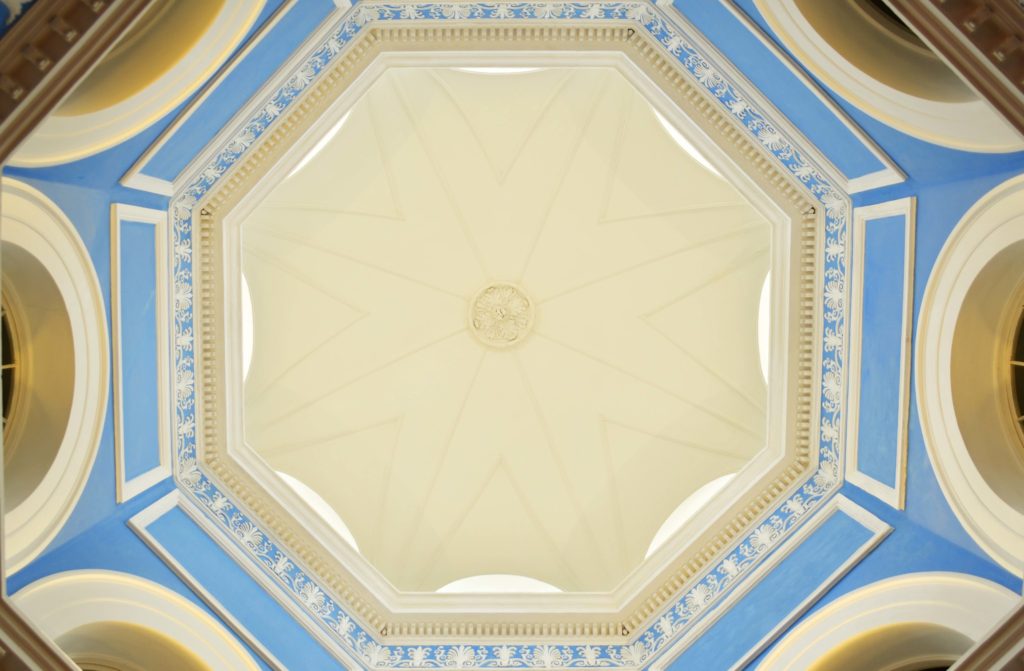
All this has resulted in serious structural barriers for Classical Archaeologists in pursuing community archaeology work. This includes lack of incentives for junior tenure track faculty pursuing such work, minimal funding, or the relative prestige of certain types of archaeological publications. Likewise, graduate training in Classical Archaeology typically does not incorporate skills necessary to do effective community-based archaeology, such as basic understanding of ethnographic methodology and ethical principles in the social sciences. (My colleagues in a socio-cultural anthropology seminar were aghast that a basic understanding of the modern geo-politicial context of the Mediterranean and the origins of my discipline were completely absent from my training. I have since decided that Hamilakis’ Nation and Its Ruins and Herzfeld’s Anthropology Through the Looking Glass really should be required reading for any graduate student working in Greece!) Additionally, to pursue effective community based archaeology, at a bare minimum, requires proficiency in the language of the communities in which one works. I have worked in Greece for the last five summers and still have only the most basic conversation skills in Greek. Instead of learning to speak Greek, I have spent much of my early graduate career trying to master Ancient Greek, Latin, French, and German, languages that are actually required for my degree. I am not excusing myself from my lack of proficiency in Greek––there are many in my program who have managed to learn Greek alongside these other languages. But it remains clear to me, from a structural perspective, graduate programs such as mine are not foregrounding knowledge of spoken modern languages in archaeological education.
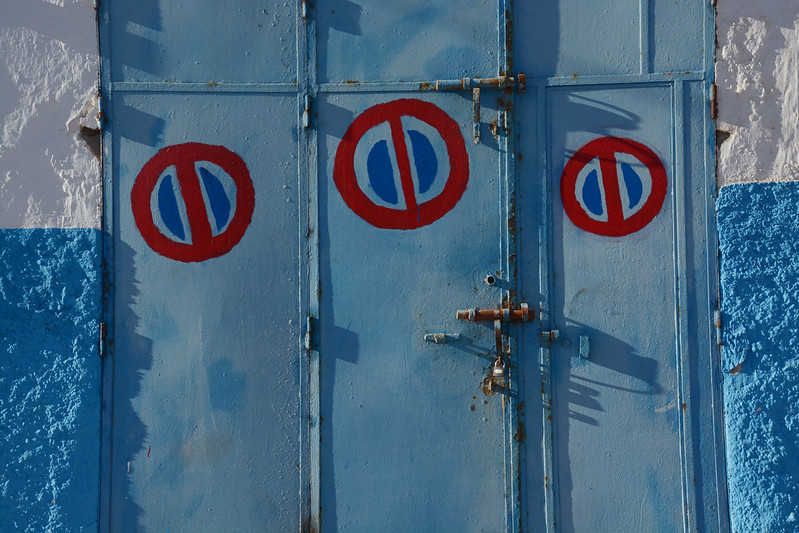
In our first BEARS season, which seems o so long ago, our team did not pursue any form of community-based archaeology. For the most part, we were simply trying to stay afloat completing our archaeological research and trying to do it well (of course, this was the work that was laid out in the grants and fellowships that were financially supporting us!). Despite this devotion to our archaeological research, our team did not remain in an isolated compound, apart from the hustle and bustle Porto Raphtis––a common critique of Classical archaeologists. On one day of fieldwork, we were lucky enough to be joined by a local poet, who described the kinetic beauty of work; our faithful captain Vasilis, and his son Odysseus, became important members of our team; and of course we frequented the tavernas and cafes that lined the city’s seaside (editor’s note: Joey and several other members of the team also became good friends with Herakles Tsonos, our supervisor from the Greek archaeological service). It is also clear that there are serious obstacles in pursuing effective community-based archaeology at Porto Rafti. For one, there are issues of permits, planning, and finances. A well-conceived community-engaged archaeology project requires close attention to local history and social bonds forged through sustained conversation. This requires the right personnel and years of planning – neither of which our current archaeological project is equipped to do. Also, Porto Rafti seems to lack a community environment that you might expect in Greek city or village. The city is relatively young and lacks a feeling of deep generational community. There is also no plateia, and there many, many vacation homes, rather than year-round residents. All this makes the prospect of doing some type of community work daunting.
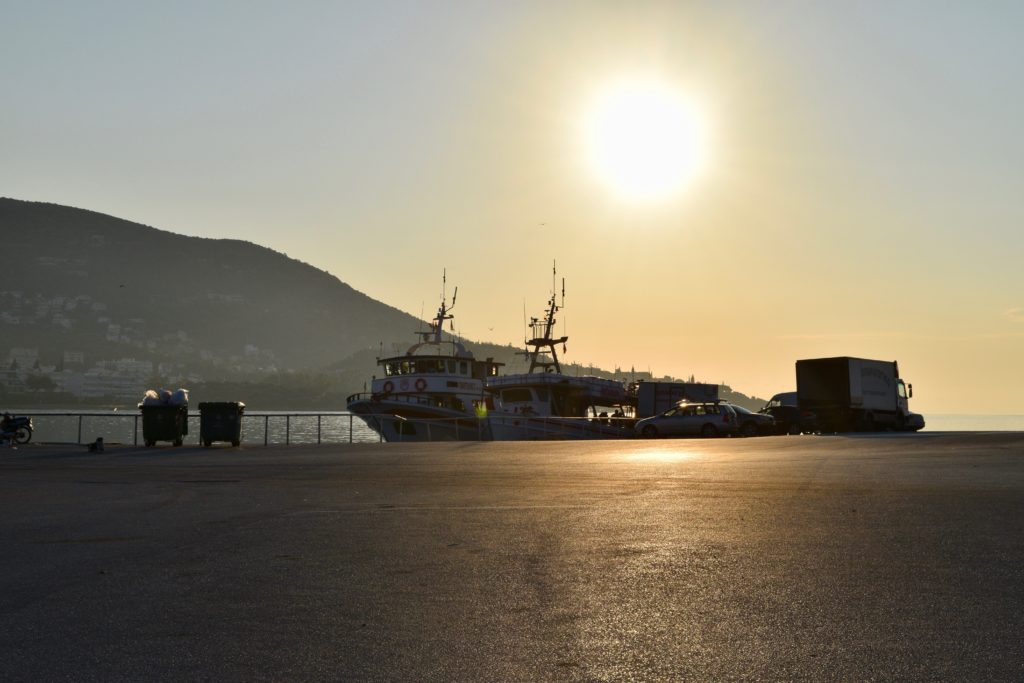
This blog post is really meant to think through this problem and envision what community-based work would look like at Porto Rafti. I am under no illusions of the difficulties it would require to undertake such work, but I do hope to offer a few starting points that might help our project begin to look outward and integrate our research into the contemporary context. So, here are a few possible starting points, however modest, for moving towards a community-based archaeology at BEARS.
1. Start conversations with the community. This seems basic, but it is truly the first step. Community archaeology should emerge from the needs of a community, not from the research agendas of archaeologists. These conversations might emerge from public presentations about our work or “open house” style discussions. These discussions are important for identifying what archaeology and the past mean to the residents of Porto Rafti, while detecting interest in specific elements of our project.
2. Regularly discuss the contemporary context of our work as a team. Why do foreign archaeologists work in Greece? This is such a fundamental question, but one that needs to be discussed again and again. As a team, it will be important to understand the role of foreign schools in Greece and the essential critiques of the schools generated by scholars like Herzfeld and Hamilakis. Furthermore, we need to understand Greece’s current place in geo-political conflicts of the last several decades and the way in which archaeology fits into past and present conceptions of Greek nationalism. These are all BIG subjects, but such conversations are an essential starting point for critically understanding our own positionality as foreign archaeologists.
3. Collaboration and connection by thinking about the past and present. During the roundtable, I noticed that many of the best elements of the community-based projects revolved around points of similarity between the past and present. Most often, these were the similarities between the ways in which people in the past and people in the present utilize local resources (whether in the process of food consumption or artistic production). Our interest in ancient Porto Rafti focuses on the bay, its settlement patterns, the exploitation of marine resources, and the waterway as a source of connectivity. Connecting with those who work at the city’s main port, fisherman and sailors alike, might be important first step in understanding the connections between our material interest and current issues of climate, resources, and topography. This would also be important in understanding the way that the ancient landscape has affected contemporary life, such as the designation of Raftis and Koroni as archaeological zones.
When we (hopefully) return to Porto Rafti this summer for a full field season, I’m not sure how well we can act on these suggestions. We’ll have a lot of archaeological work ahead of us and community-engaged practices are time consuming and significant labor. So, I hope this post will serve as a conversation point as we move forward to reflexively consider our research and our role as foreign guests in Porto Rafti.
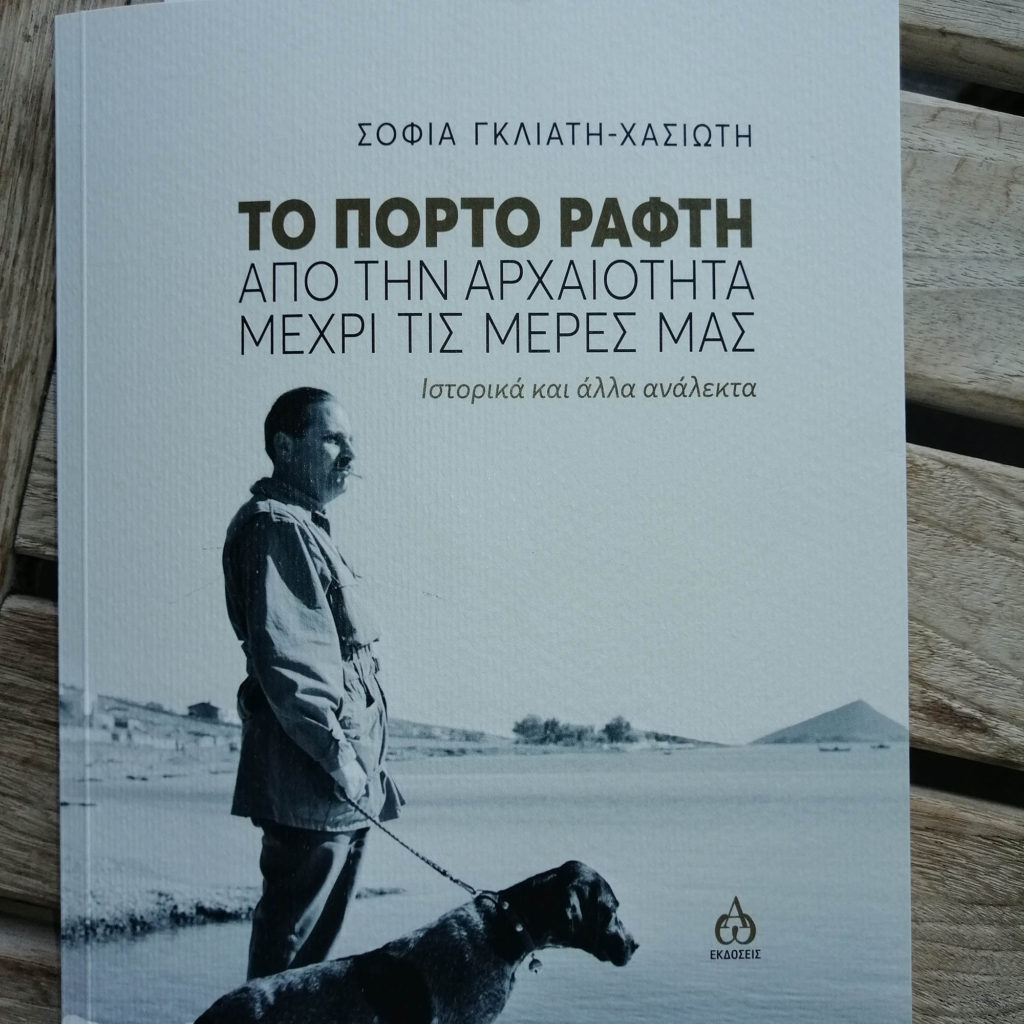
Archaeologist Confessionals Volume 12: Melanie Godsey
Who can get enough zoom conversations these days?! After a long semester spent staring at/talking to my computer screen, I was feeling deprived of online meetings over the holiday break, so I dialled up UNC PhD student, intrepid BEARS Hellenistic pottery expert, and current locked-down Athenian resident Melanie Godsey for an invigorating interview about archaeology and other stuff. Like several other members of the BEARS project, Melanie came to us very highly recommended from the leadership of the Western Argolid survey (WARP), which grad student roster I shamelessly raided for talent when putting together the team. Alas, she wasn’t able to hang around Porto Rafti very much during the 2019 season due to other preexisting commitments, but she was pretty much the only person keeping me company in the Brauron museum for most of the 2020 ‘study season’ that took place this past August, when she heroically blasted through all of the historical pottery that we collected on the Koroni peninsula. Read onward to find out more about her intellectual background, fascinating research on Ptolemaic interconnections, and recent exploits in Greece, including many tantalizing autumnal photos of “the Raft”.
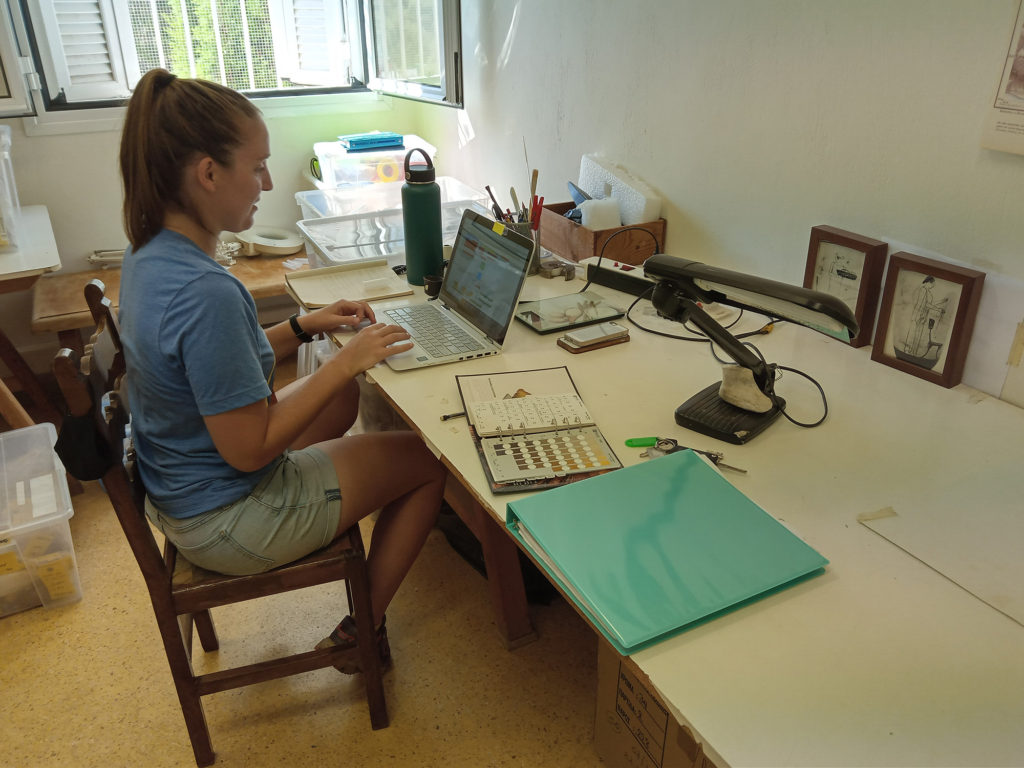
SCM: What got you interested in Classics/Archaeology and why you decided to pursue a PhD in the subject?
MG: I definitely got here by accident, basically because someone told me I should do Classics. I showed up on the first day of college, and I went to the history department, where they asked me what I was interested in. And I told them, and they said I was in the wrong department – I should go to Classics. So I went to Classics, and it all worked out. But I still ended up double-majoring in history, too. I couldn’t really decide if I wanted to study languages or archaeology for a while, and I was really interested in the whole discipline. But finally I decided that archaeology was what I wanted to do based on my one summer of fieldwork and some other courses. From then on I was pretty into Classical Archaeology, and I applied to grad school just to keep it going. I wasn’t sure if I’d continue beyond the MA, but I kept enjoying the work, especially the fieldwork, and got the chance to work in Greece (at WARP! A popular choice among BEARS-ers) and that sold me on sticking with this forever (hopefully).
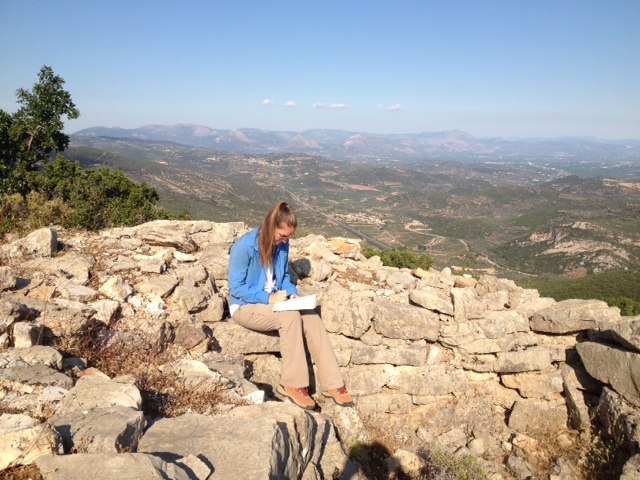
SCM: Cool! I can see why working on a fantastic project like WARP would turn a person into a lifer! So where are you currently in the program and what kinds of research are you pursuing?
MG: I am at the University of North Carolina Chapel Hill in the Classics department. I think I am in my sixth year (I think?); but who knows anymore! I am working on my dissertation now. I’m focusing on the social and economic relationships between Ptolemaic Egypt and Hellenistic Greece and how that plays out in material culture. I’m working mainly on ceramics – daily use stuff, fancy stuff, and also transport amphoras, to get a sense of how economic networks and long-term imperial goals may have changed and impacted the way that the two entities interacted: from both the Egyptian and the Greek side of things.
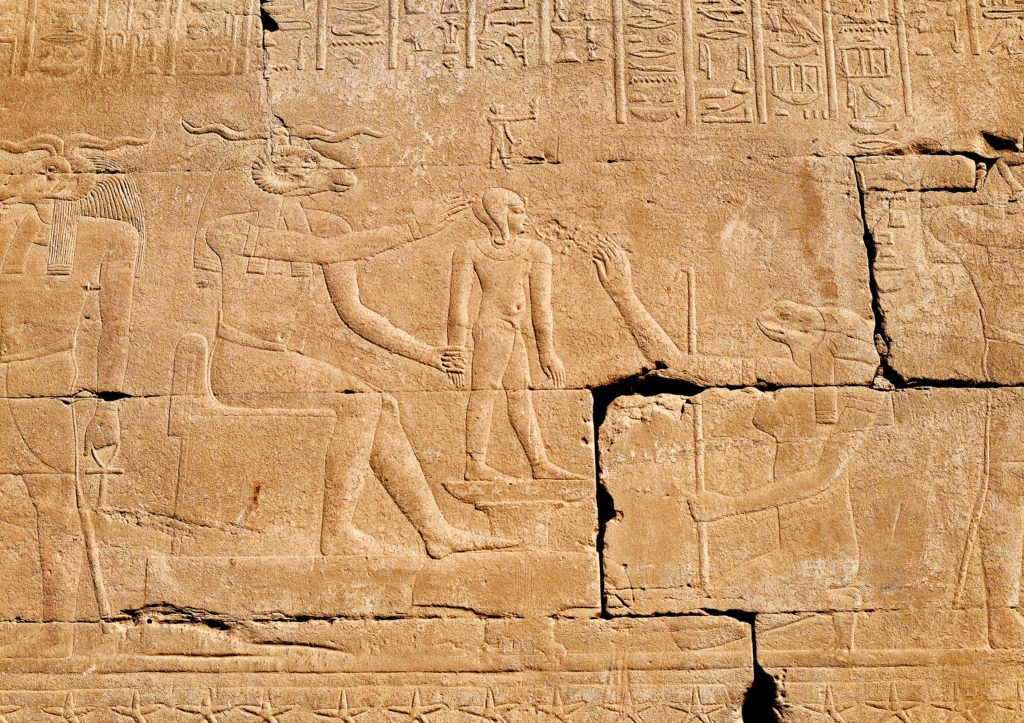
SCM: It is a really great project – Ptolemaic sites in Egypt are out of control: it is just amazing how much pottery there is at sites in Egypt and how little people seem to care about it! So, I’m guessing that there is a pretty large amount of work that remains to be done on that kind of material….
MG: Yeah, it’s very niche! There is a handful of people that work on this kind of stuff, but it’s a pretty small community. Which Ptolemaic sites have you been to?
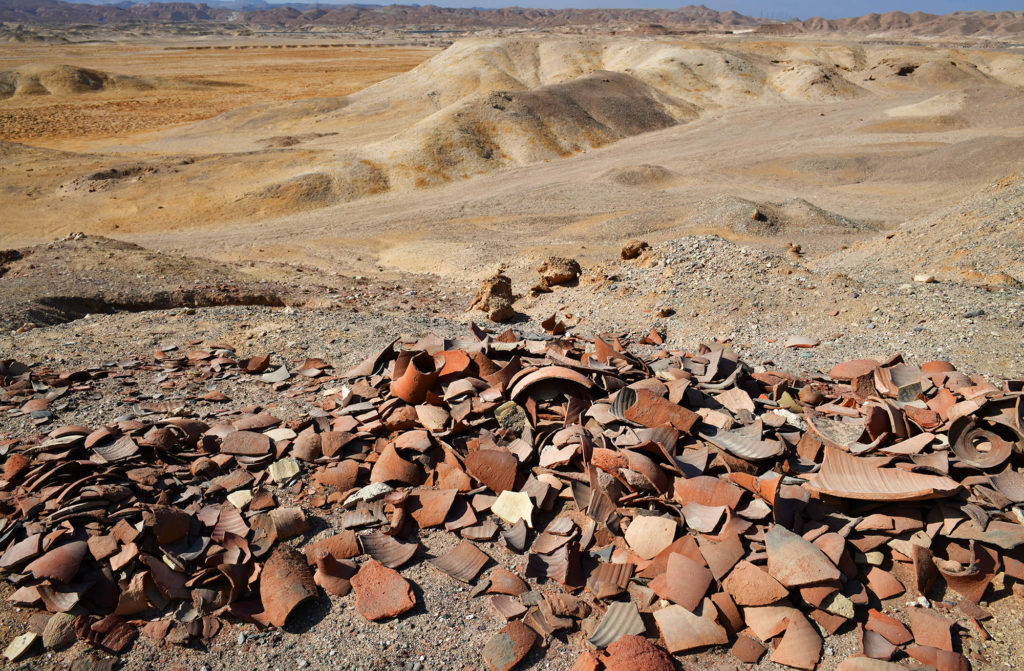
SCM: Let’s see, a lot: Dendera is one of my favorites: just a huge and crazy site with incredible preservation and fascinating reliefs, but also a bunch of other temple sites in the Nile valley. Also several places out in the deserts: Dimai north of the Fayoum, with mud-brick walls standing over 10 meters tall, some coastal and mining sites near Quseer and Wadi el-Gemal on the Red Sea, and several temples/forts in the western desert oases. The desert is crazy! For a surveyor anyway: the amount of pottery and preservation of it on the surface is one thing, but then you find all this other stuff: glass, big chunks of faience vessels, fishing nets (!), pieces of leather and cloth…..YEESH and the visibility is obviously 100%. And no thorns! As a surveyor at those sites I was kind of tweaking out a little bit. Not to mention the scale of the architecture alone.
MG: Yeah survey in the desert must be crazy! The opposite of Greece.
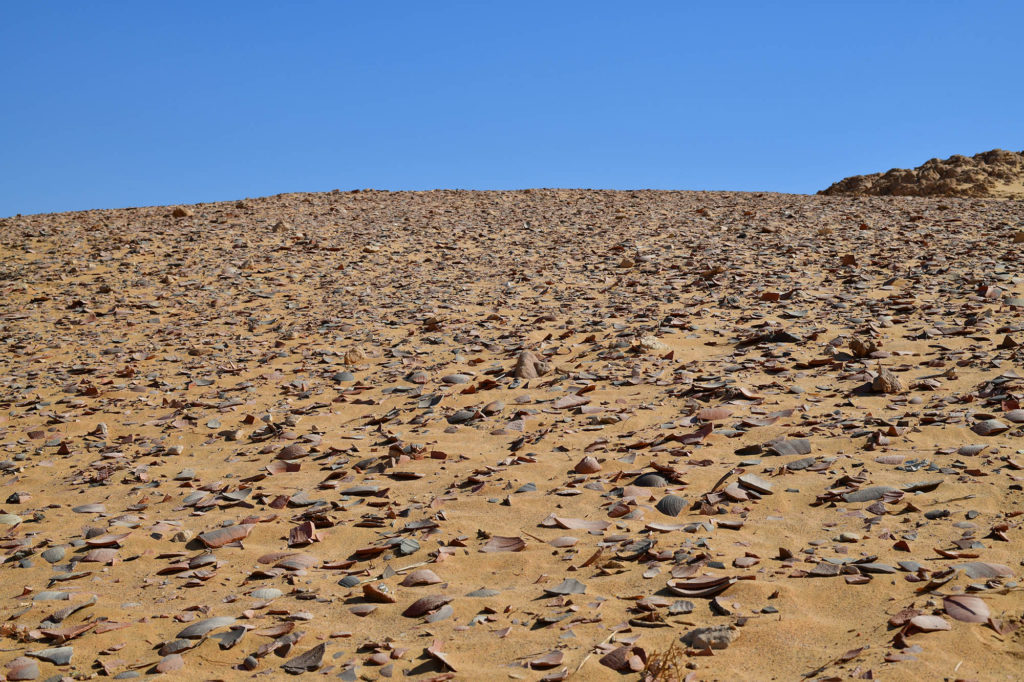
SCM: Totally. So you’re researching this super niche topic, not your average dissertation area! Can you tell us how you got into this as something to study?
MG: I knew I wanted to do something with pottery/ceramics after my first year of grad school. I was really interested in the questions that ceramics can answer about trade, about daily life, and the mundane aspects and tasks of peoples’ existence. Pottery is the most common thing that you find everywhere, so I thought that was a good avenue into lesser-studied questions. With Ptolemaic pottery, it happens that my advisor is one of the few in the U.S. who work on Ptolemaic pottery! And it’s been very interesting to see how this operates, because Egypt didn’t export a huge amount of pottery, but there is a ton of other evidence for connectivity between Egypt and the rest of the Mediterranean. People will say, oh Ptolemaic pottery I’ve never even seen that!, but that doesn’t mean that there wasn’t a ceramic result to these cross-cultural interactions. So that’s sort of how I ended up working outside of Egypt at least for my dissertation. I hope that will bring these two fields – Hellenistic Greek pottery and Egyptian Ptolemaic pottery – together a little bit.

SCM: That is really interesting; and I am sure that the results will be super useful for the field, in terms of perhaps revealing these complex relationships that haven’t been discussed so much in new ways. Having worked some on ancient trade myself, but in a prehistoric context, I am always troubled by how we rely so much on pottery in prehistory to tell us the whole story of interaction and networks. But Ptolemaic Egypt is a really compelling case, because it’s clearly really connected and cosmopolitan, but the pottery might not show you that in terms of being spread around as a trade product per se. And I guess you could think about the iconography and architecture as sort of stealthy when it comes to serving as a proxy for anything about intercultural exchange or interaction too. It will be interesting to see, methodologically, and in terms of interpretation, how the results of your study play out and what they suggest about the whole bigger issue of interpreting cultural connections and networks through archaeological remains.
MG: Yeah, absolutely, and I think in the Hellenistic period the same thing happens; people are always looking for faience or something as this concrete indicator of exchange. But maybe something more nuanced can come out of my approach which is a bit more dialectic I suppose.
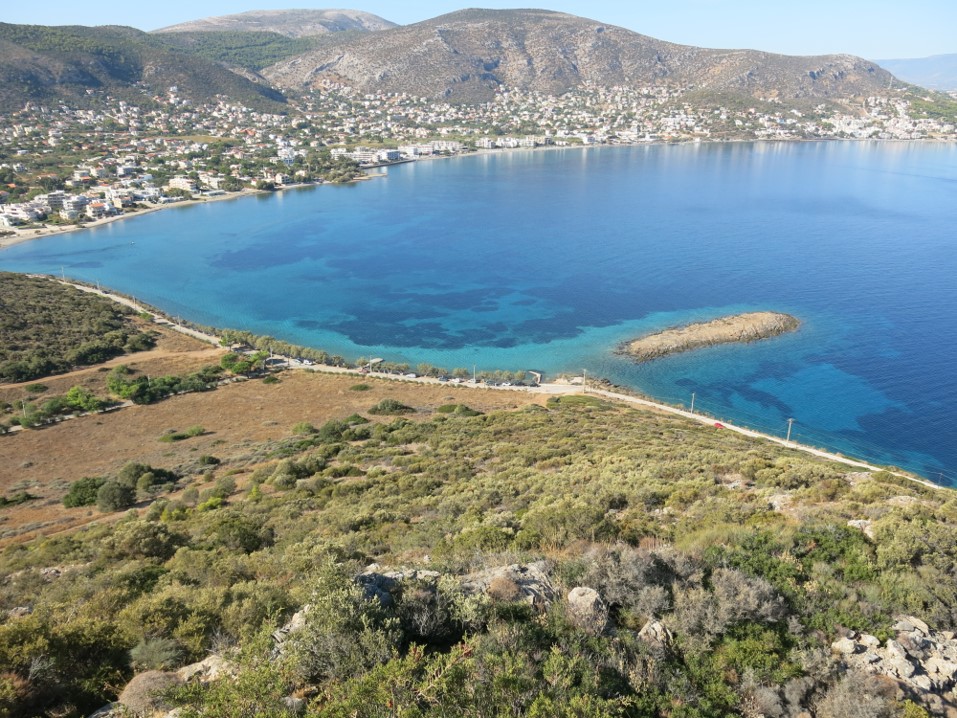
SCM: It sounds like you’re pretty deep into the whole dissertation project and obviously making good progress and getting into the trenches with that. Looking back on the earlier parts of your graduate student career, are there any particular experiences or courses that you remember fondly or that had a big impact on your intellectual development?
MG: Hmm, that’s a hard question! There were a couple of courses that really impacted the way I see and understand the field quite a bit. Two were archaeological theory courses – one taught in the Classics department and one in the anthropology department. Doing those both in the same year was really eye-opening, to think about how archaeology operates differently depending on where you work and the conscious decisions made in the data collection and data processing stages. Classical archaeology has a pretty unique approach, and there’s a lot that Classical archaeology can learn and draw from other approaches. The other class that I took was on context and assemblage theory – we talked about how all types of material culture are enacted and changing in different spaces all the time. It was really relevant to anyone who thinks about anything material across disciplines – there are so many ways to think about how we archaeologists interpret and create material assemblages. Those were definitely the most influential moments of my coursework in grad school.
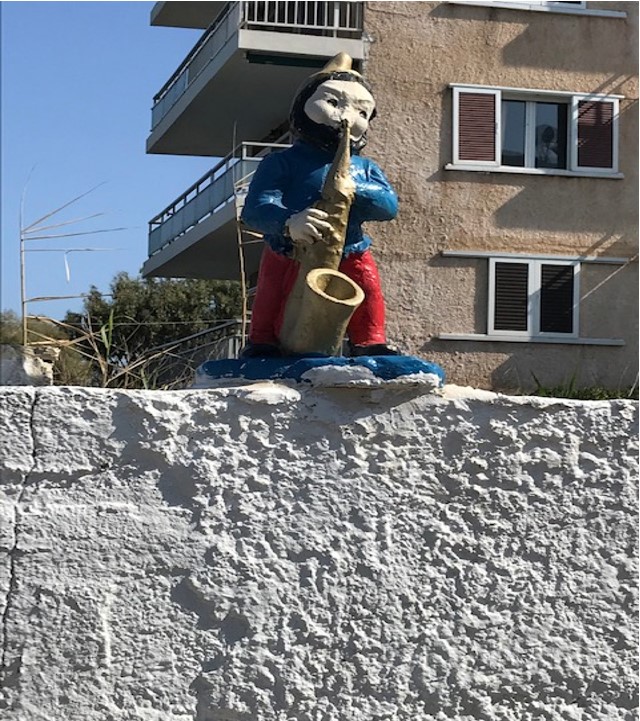
SCM: Wow, those sound amazing. I can hardly remember grad school at my advanced age. But I think I had kind of a similar experience, because my undergraduate education had taught me a lot about objects and stuff, like what temples look like or whatever, but then in grad school I actually learned what archaeology really is – not just memorizing words for parts of temples, but sort of a philosophy of how to understand the world. I basically never got any of that stuff in Classics, or not until I got to grad school anyway.
MG: Definitely!
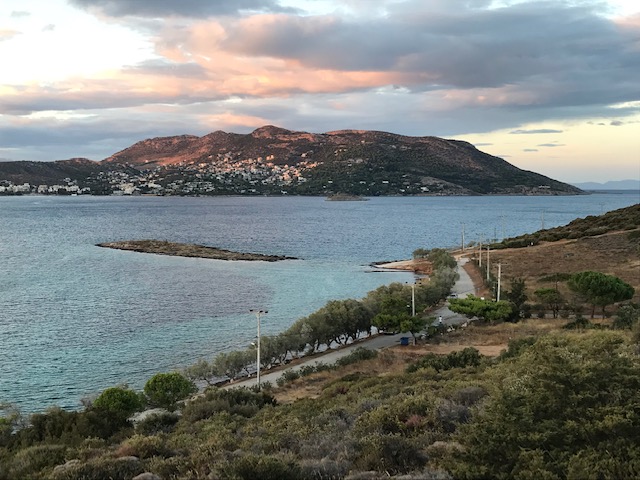
SCM: Okay, so you’ve done a ton of fieldwork – let’s hear about your range of fieldwork experiences and the kinds of work you’ve done in your career as an archaeologist so far!
MG: Sure thing! My first field school was in Italy, at an Etruscan site called Cetamura excavated by Florida State University. I really enjoyed working there, but my next project was a field survey (WARP!) with a totally different set of goals and research questions and methodology of course. It was really fun to do that so early on in my graduate career and get experience with two totally different sorts of field archaeology. Since then I’ve done a good mix of excavation, survey and (more recently) a lot of finds processing – mostly from Hellenistic sites in Egypt (French Archaeological Mission of the Eastern Desert and Abydos), Cyprus (Pyla-Vigla), and Greece (Corinth, Sikyon, WARP, among others).
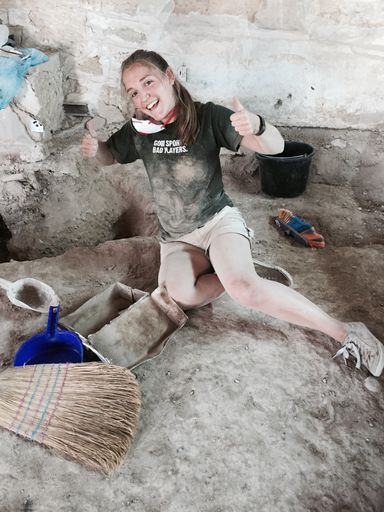
SCM: Yeah, it’s very much to your credit to be seeking out all of these different opportunities in a kind of omnivorous way. I think that’s kind of ideal for a grad student, to flit around and check out a lot of different projects to see how things are done differently in different contexts, and get a sense of the range of archaeological approaches to fieldwork. I’m sure that exposure will serve you well going forward. If you had to choose one aspect of work in the field that’s your favorite, what do you think you’d pick?
MG: Oooh, hard one! I don’t know! Despite my love for ceramics and how much time I spend with pottery, I do prefer being outdoors doing something. The range of possibility is pretty open-ended, but generally I prefer to be outside, even if it’s just at a pottery table outdoors; anything that gets a person outside and active.
SCM: I totally agree. I would always rather be outside.
MG: Especially in the Mediterranean.
SCM: Right, maybe different rules would apply in Greenland.
MG: Who knows? It sounds cold though.
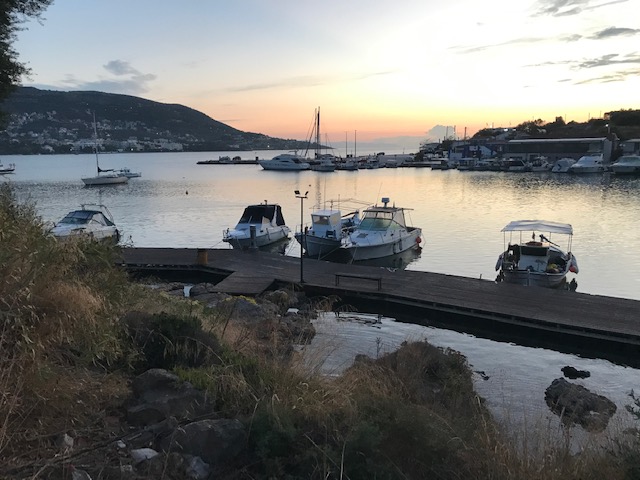
SCM: Okay, so one thing that I often think about when it comes to archaeological research in Egypt is, of course, the risk of awakening or disturbing Lovecraftian horrors of the undead, activating ancient mummy curses, and having other various terrifying/exciting adventures related to the Very Extra nature of the Egyptian archaeological record. Now working in Greece, I’ve never experienced such adventures, but I’m guessing that you must have.
MG: Actually no! I’ve not had any undead encounters or fracases with animate mummies. Do I even have any crazy stories? I think crazy things happening to me has been limited to plans for the day being totally derailed by whatever – a really nice farmer who wants to get you drunk on raki because you were walking near his field early in the morning and you hang out at his house all day and don’t get anything done; or something really exciting happens at a nearby site so you take the day off to go check that out. It’s always exciting when something cool throws a wrench in those plans and you get to experience some entirely different thing that’s happening in the world.
SCM: Oh yeah, the 9am raki drinking break! I’ve definitely been there. I generally find it hard to be very productive after a big karafaki of raki before noon.
MG: Quite a challenge, yeah!

SCM: I’m also kind of heartened to hear that I’m not really missing out on a lot of encounters with the undead just because I don’t work in Egypt.
MG: Hasn’t happened to me yet – but there’s still time!
SCM: Yes, indeed, perhaps something to look forward to post-pandemic. Now, you’re currently in Greece and have been living there more or less for the last year and a half. How has that been, COVID times notwithstanding?
MG: My intention when I moved here more permanently last fall was to do the regular year program at the American School of Classical Studies in Athens, which was wonderful. We almost beat the pandemic: it just caught us at the end! Nevertheless we went to a ton of archaeological sites and talked about archaeological problems on the sites where those problems came to be known; that was definitely the most memorable experience that I’ve had; just getting to travel around in this bus and going to so many beautiful places in Greece. We were based in Athens and really got to know the city quite well and meet people living in different parts of the city and all that kind of stuff. This year I am back in Athens, but I also spent a month in October in Porto Rafti, which was wonderful! I got to know old Porto Rafti in a new way, since I hadn’t been around there too much before this year. Unfortunately, right after that we entered the lockdown again, so I’ve just been kind of working in a sedentary way for a while. But it’s been really nice; much better than a lot of places I could be right now. I feel really lucky to be here and to have gotten to spend so much time in Athens and Greece lately.
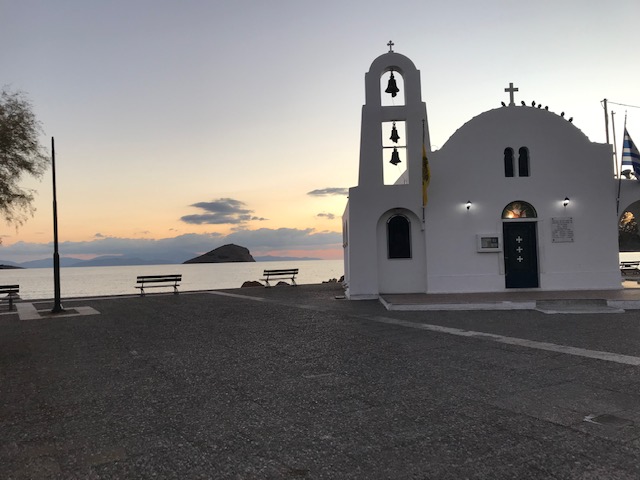
SCM: Amazing! I’m really jealous; I never lived in Greece for more than a few months at a time in grad school, which I really regret. I hope that the lockdown ends soon and that there will be some more months of fun stuff ahead!
MG: I hope so too!
SCM: But thinking back about better times in the fall, tell me about your glamorous October on the Porto Rafti Riviera.
MG: It was fun! Surprisingly it was still really crowded on the weekends all the way through October, even though there was a pandemic on! Apparently, nothing can stop Athenians from going to Porto Rafti on the weekends. But during the weeks it was pretty mellow, and you could walk around pretty easily, which is not always true, since it is not the most pedestrian friendly place. It was still possible to swim in October too! I spent a fair amount of time wandering through the area and climbing up out into the surrounding hills.
SCM: Did you discover any secret best favorite bakeries or restaurants or cafes that you’d like to share with those of us who might spend some more time in Porto Rafti in the future?
MG: I went back to Fyki Fyki, which is definitely on the favorites list. I did test out all of the different coffee options along the water, and I can report that all were very good, so you can’t go wrong with a freddo around there.
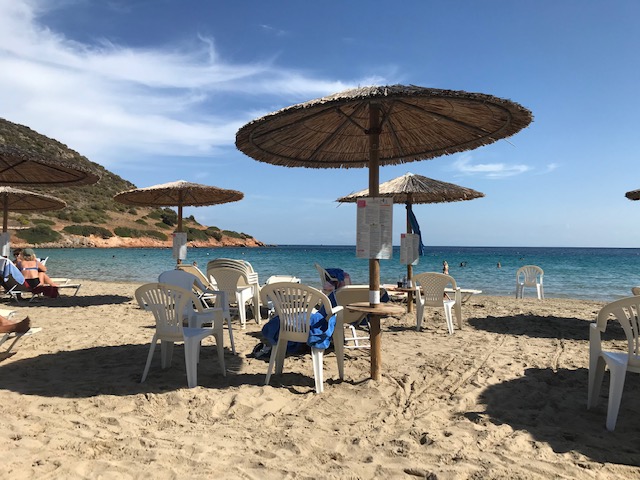
SCM: Good to know! Aside from Porto Rafti, do you have a favorite place or site in Greece, as a place to live/hang out or in terms of the archaeology?
MG: I really love the site of Messene in the Peloponnese, which is in a really beautiful location, but I also like the way that the site has been set up for visitors. You can walk most of the fortification walls, which is really cool, and the Hellenistic stuff there is really great, so it really appeals to me in terms of research as well.
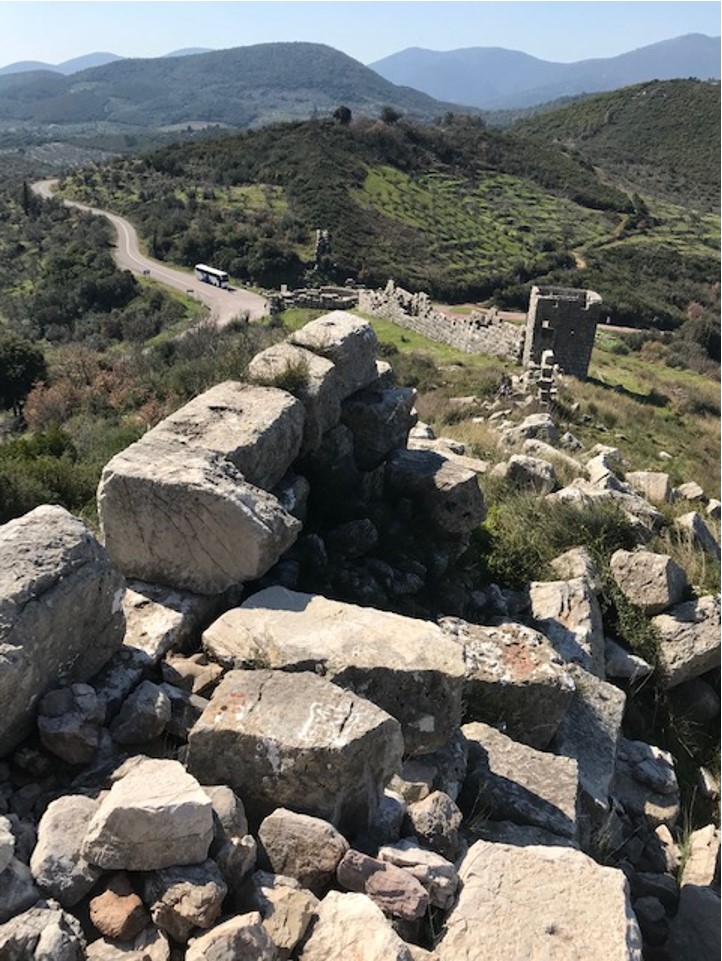
SCM: Great choice! I haven’t been there forever, but the landscape is definitely very choice in that area; in the notorious “DEEP Peloponnese” generally. And the fortifications are super cool. For now, I guess we can’t really go see any sites in Greece: do you have big plans for after the lockdown? Places you’re going to head in Greece once it’s allowed?
MG: I’m most excited to get back to fieldwork, basically of any kind. Not necessarily in terms of pursuing research questions or the thrill of discovery, but mostly for the camaraderie of the field team, which you just can’t recreate in any other context. It will be nice to get to travel beyond Kolonaki and Pangrati too! I now inhabit a very limited circle of Athens, so getting beyond that will be quite nice.
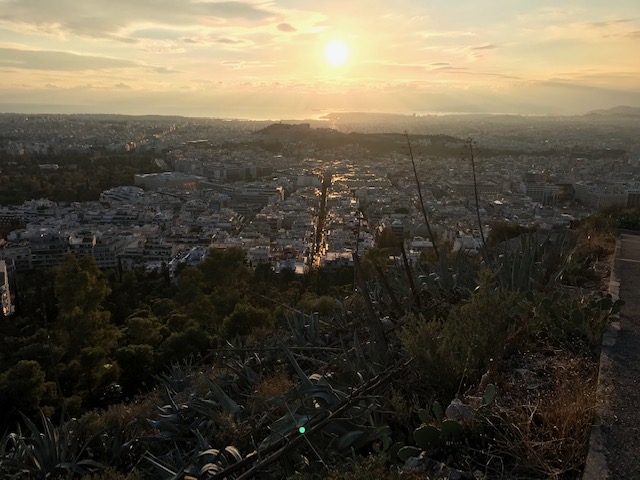
SCM: That makes sense – I am dying to have a beer with a friend somewhere, anywhere, again; the incredible camaraderie of fieldwork is kind of more than a a person can even begin to imagine after a year of hardly seeing anyone. Hopefully this summer! But who knows. For now, I’ll let you get back to wearing ruts in the sidewalks of Pangrati and Kolonaki – unless there’s anything else you’re dying to share with the BEARS blog readers!
MG: Not in particular – but I am excited for BEARS 2021 and I can’t wait to see everyone over here and meet the whole team.
SCM: Me too – I’m gonna try to do everything I can to make it happen; and now you’ll be famous, one of only three people who were a part of the extra exclusive BEARS 2020 team! Thanks for the interview and good luck with your work the rest of the winter!

Archaeologist Confessionals Volume 11: Matthias Kalisch
Over the holiday break I had the great pleasure of virtually sitting down on the old zoom unit to catch up with a couple of stellar BEARS veterans. Now that grades from the fall have finally been submitted and everyone is hunkering down for a delightful winter’s stay-at-home order, there is, at long last, time to get around to filing the latest pair of BEARS interviews here on the blog. First up is a conversation with Matthias Kalisch, who bravely represents the continental European student contingent on the project, putting up with myriad Canadian micro-aggressions along the way, no doubt! In 2019 Matthias joined us from Tübingen, and our interpretations in the field benefited a lot from his great expertise on and experience with survey methods, roof tiles (based on many years of work at Olympia, great land of fancy tiles), and coins. Take a seat by the fire, pull up an electronic device of your choosing, and check out what he has to say about a huge range of topics, from archaeology to musicology, not to mention a bunch of great photos from Greece and Porto Rafti that Matthias was kind enough to share for this post!
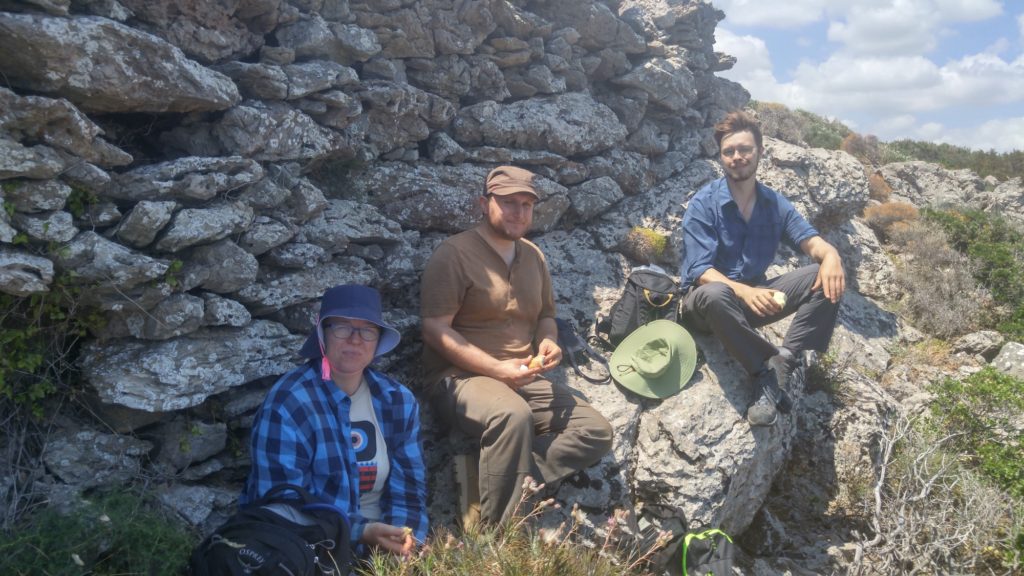
SCM: How did you first get into archaeology and how did you decide to pursue Classical archaeology as a career?
MKK: I was always interested in history and archaeology. As a child for me it was very interesting to look around in Germany because you had all these castles and places which had this long history which is kind of forgotten sometimes. In most of the forests you can walk inside and find the remains of all kinds of castles and things like that. At first I was really into the medieval era, but then when I went to school I got more and more interested in modern history. So that’s what I started studying at first. I don’t know exactly how it works in Canada with the undergraduate program, but in Germany you go to university and you have to know already what you want to do. I started out studying history and musicology. History is still something I really like and am interested in, but at some point, the way that history was taught made it seem like a field I didn’t really want to continue in and a place that I didn’t belong. In my second year, I changed my major from history to Classical Archaeology. I got into Classical Archaeology and the work with this material was really very appealing to me, in comparison with working just with textual sources.
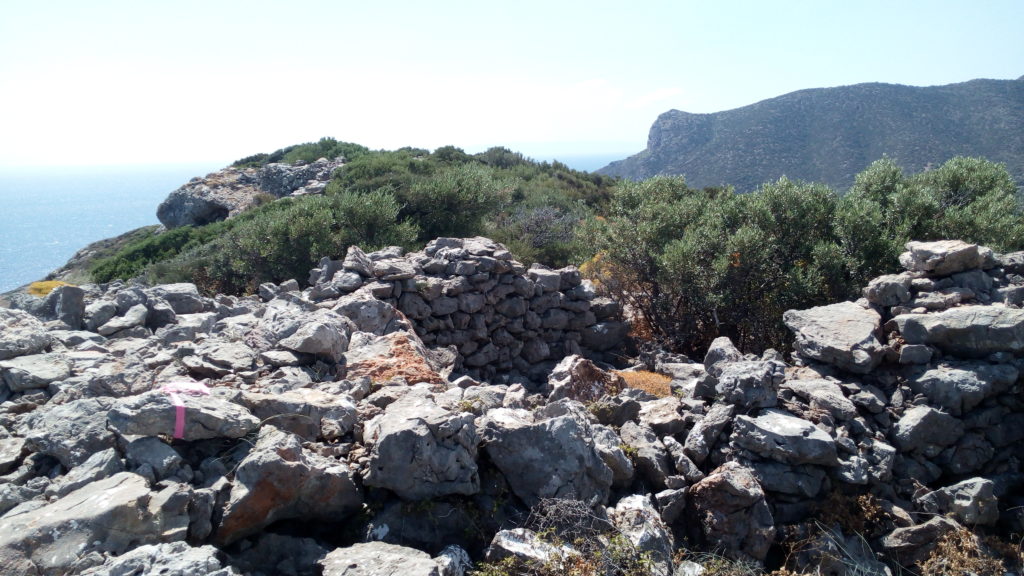
SCM: Right, I see – now tell me a little about the musicology thing! Where did that emerge from?
MKK: Music was always a big deal for me because I play the drums and percussion, and I have been playing in an orchestra now for nearly twenty years. This is also not possible at the moment, which is really sad, because during Christmas time it’s such a cool time to be in an orchestra with all of the Christmas markets and we have a big concert on the 25th every two years. So music was kind of something I was always interested in, and I was especially interested in the history but also in the structure of music: what is music, how is it constructed, that kind of thing. I decided to start musicology because compared to studying an instrument, it’s a very theoretical field, which I liked. This is something cool about music – it was the only ‘mathematical’ thing I ever really found appealing. In Tübingen musicology was very focused on Mozart and the so-called “Wiener Klassik”; we have a very Mozart-focused faculty. But that changed when I was there because a lot of the faculty retired to be replaced by younger professors who had different interests and energies. What I really enjoyed studying was dodecaphonic music, like 12-tone music, because it’s something unpleasant and weird to listen to, but it is a really interesting field of study in musicology, in terms of how that music expresses ideas that other types of music can’t express as strongly.
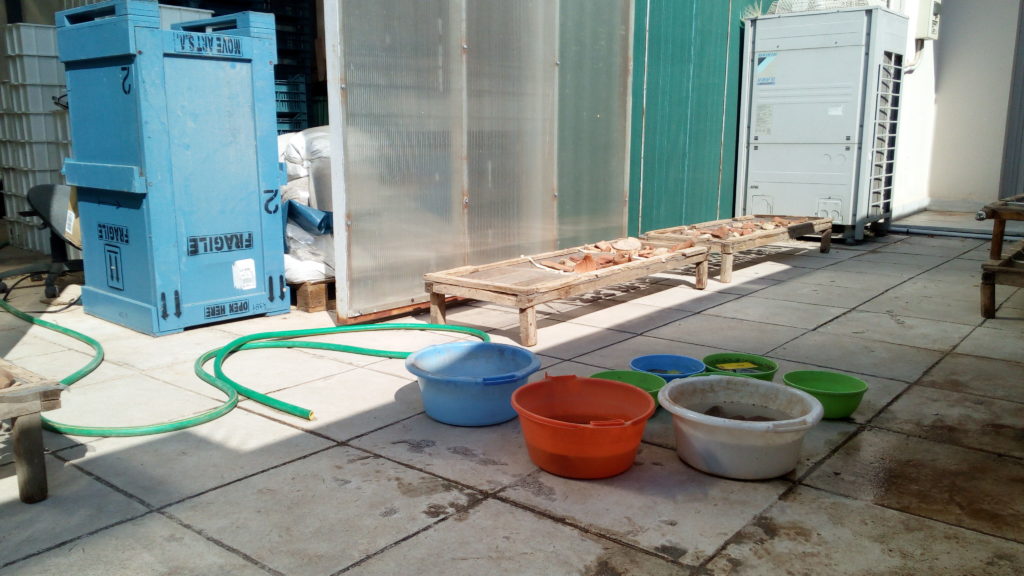
SCM: That is fascinating! I know very little about music. Did you know that Taylor, fellow BEAR, is a talented clarinetist?
MKK: Yeah, we talked about that when we were living together in Porto Rafti!
SCM: Next year you should make a little BEARS band, and you guys can play for us in the evenings.
MKK: Usually I take my ukulele to projects, but I couldn’t last year because I didn’t come to Greece straight from Germany. But I definitely will bring it next year.
SCM: YES. I am going to make it a requirement!
MKK: Okay!
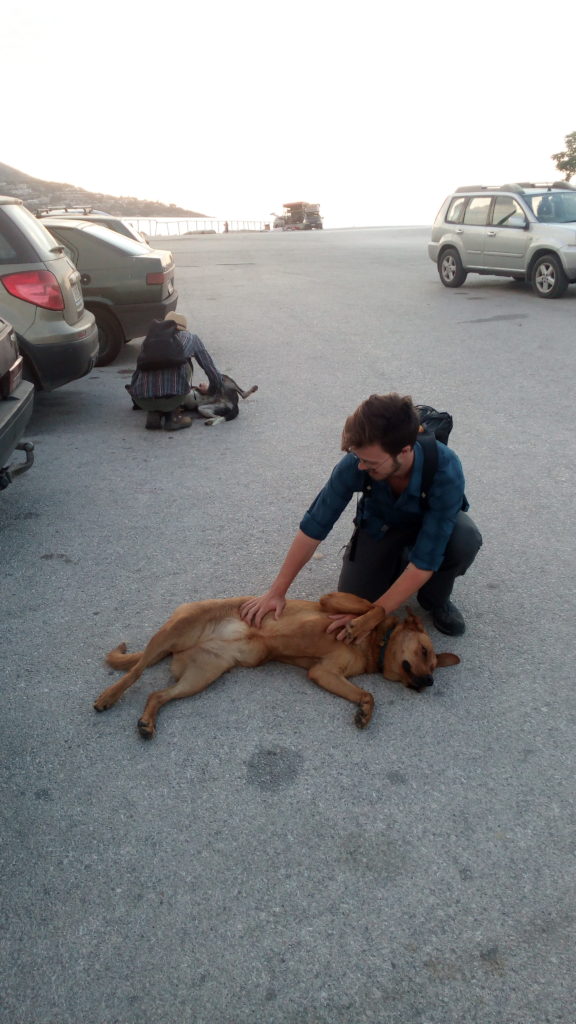
SCM: Okay, so back to archaeology I guess…. What are your main research interests these days? Are you working on anything in particular?
MKK: Because we were not able to go on projects this summer I was able to finish some articles I have been working on and planning to submit. One was a numismatic paper, which is a field I’m very invested in. The other one was about climate in the Ionian archipelago, which was something I didn’t have much experience working on, but which was really exciting to learn more about, because I think that climate has been generally disregarded in Classical Archaeology so far. This is something that prehistoric archaeology deals with a lot, with excellent results, but nobody really deals with it in Classical Archaeology, so I think there is a lot of room for growth there.

SCM: Yeah, good point. In prehistory lately there has been a ton of work on the climate as a driving force in change, but not so much on the historical periods. Cool stuff! Now, returning to the numismatics issue – this is a topic that many archaeologists think of as quite unexciting, or even boring. Can you explain to us – explain to the world! – what’s so wonderful about numismatics as a research topic?
MKK: Ha! What to say? Look, numismatics might appear to be a boring topic at first glance, and I know why it has this reputation. Numismatics is often regarded as the study of something totally unconnected to the whole site or the bigger picture of the project. People assume that you do it in a small chamber in the basement with your magnifying glass, just identifying the coin by emperor or city and being totally isolated and pedantic. Of course, if you approach numismatics this way it is very boring! What I think is that coins as an archaeological source are very interesting and very important. There are several problems you might find when you try to use coins as an archaeological source, especially in terms of documentation. The research I did for my bachelor’s thesis was on the numismatic material in the four Panhellenic sanctuaries, and the point was that there is no publication of this material! There are coins from the sites, but everyone has basically ignored them. There is a fair amount published on Nemea, but the coins from Delphi and Olympia have barely been dealt with. From Olympia, maybe 500 out of several thousand coins have been published! That’s very sad, because when you look into the material closely you can find the same things you see in other studies of artifacts – patterns in history of use in coins, change in the use of parts of the site over time, etc. So that’s what I am trying to do: to approach numismatics from a different standpoint. In my opinion, it makes it more interesting than old-school numismatics. But it’s also very hard to do this work, because you oftentimes have issues with poor recording of the archaeological contexts for coins, which you can’t really fix, no matter how sophisticated your analysis.
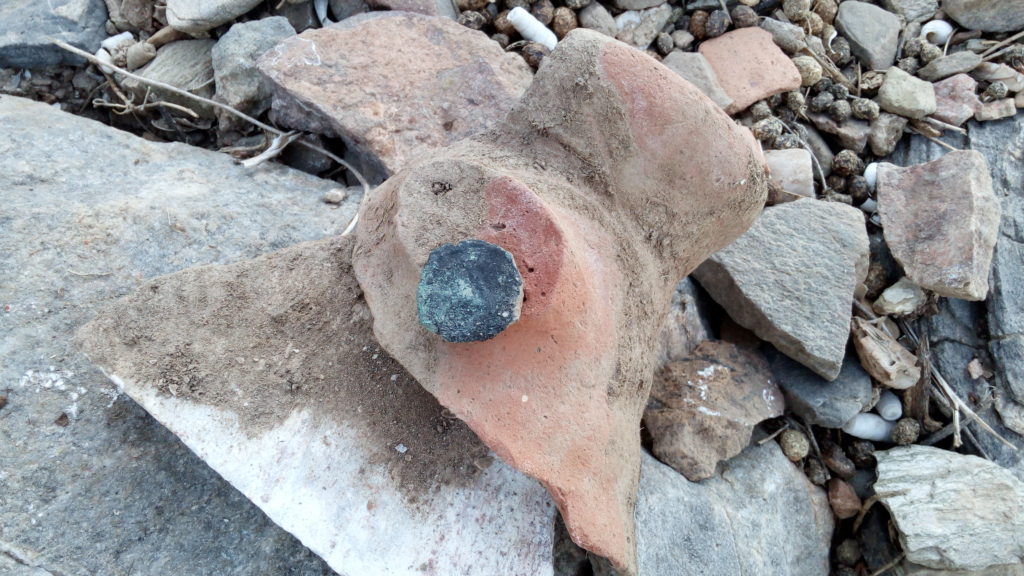
SCM: Amazing! I’ve never been so interested in coins! I also had no idea that there were sooooo many unpublished coins from Olympia. What a cool project to resuscitate meaning and interpretation into a big body of evidence from such important sites!
MKK: Yeah, and it’s not just Olympia. Lots of sites have coins in the depot that are just forgotten, moldering there.
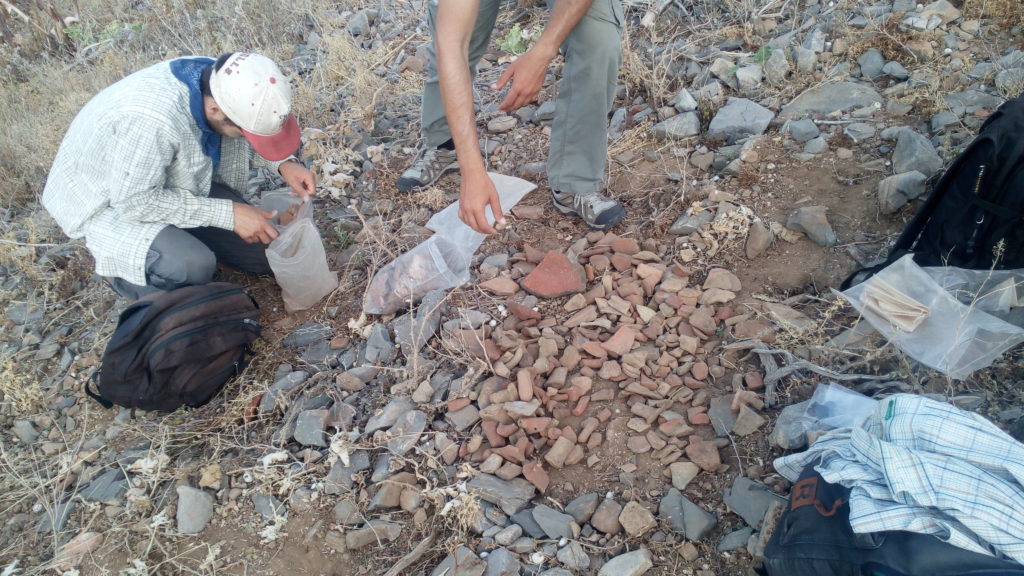
SCM: Do you have a favorite coin or coin-insight that has come from your careful studies of these assemblages?
MKK: From an artistic standpoint, I think the coins from Aegina are really interesting: I really like the turtles! But also very interesting are the early coins from southern Italy, because they look really different than coins usually are supposed to look. They don’t have relief on both sides, they have relief on one side and then the negative/incuse form on the other side. Nobody really understands yet why they did things that way locally in the region. When I started out with numismatics I thought, okay, it might be the same in Sicily because both areas are closely connected with colonization, but that’s not true. Sicily minted coins in the normal way, but southern Italy had this very special form of coins. I find this quite interesting in terms of the arbitrariness of what seems like a pretty instrumental technology.
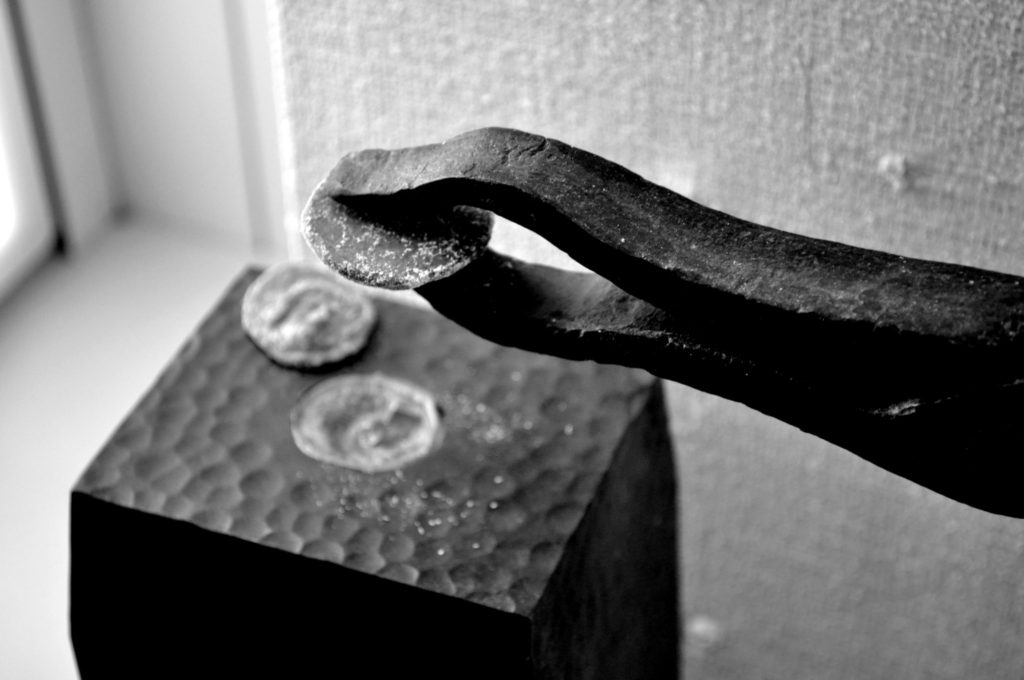
SCM: Nice! I am learning so much about coins from this interview! Thank you for sharing your expertise and insights! Now, clearly you have a ton of experience in the field, both in research and working on field projects. Tell us about the kinds of projects that you’ve worked on and the range of fieldwork that you’ve had experience with up to now?
MKK: Most of my fieldwork has been in survey and landscape archaeology projects, so similar to the BEARS project. My first project in Greece was in 2015 on the Olympia survey project. By the way, that’s why I know how many coins there are at Olympia: because I saw them I the depot! The project did a survey in the surrounding area around the sanctuary. For me this was very interesting because, in my opinion, Olympia is maybe one of the most studied areas in all of Classical Archaeology, with tons and tons of publications, but none of them really address the area around the sanctuary! We worked for several years, and covered a lot of the area around the site, and it’s just impressive how much information you can get out of these surface assemblages. The question is still how people who came to the games or to the festival in Olympia were managing – where did they get their water and food? – and nobody has really looked for such details in the archaeological record. The survey was trying to address that kind of thing, and it was really impressive: some of the stuff that we found in the survey had been documented in maybe a single sentence somewhere from a casual traveler; but having a close look at all of these things really helped us to understand the bigger dynamics of the region around Olympia.
I also went to two projects in Italy, because Tübingen has some more Italy-focused research areas. We conducted a survey around Cosa (north of Rome, a big Republican site), also carrying out a program of magnetometry to make clear the plan of the site without excavating, especially the area of the settlement, rather than the acropolis and other fancy stuff. What was very interesting, and kind of the opposite of the survey, was also going to an excavation at Pantelleria, which is a small island between Sicily and the coast of Tunisia. Tübingen conducts an excavation on the acropolis of the city, and working there you get a really good impression of how digging works in comparison to survey fieldwork. The material is certainly different. In Cosa, we did not actually collect any material, but in Olympia most of what we found were roof tiles or scattered ceramic sherds. In the excavation, of course the material is much more well-preserved and voluminous. Although as you pointed out in Porto Rafti, the survey material on BEARS is sort of more like an excavation would produce.

SCM: Do you have a preference for certain kinds of projects, say survey work or excavations?
MKK: That’s a good question. I like both kinds of work, even though there are so different. On a survey, I like to be in different places every day, and to cover a large area, also orientating yourself every day in a new way. On the Olympia survey we actually were in different areas every day: we drove somewhere, got out, took out our maps, and had to locate ourselves, the place you wanted to survey, and everything around you. That was very intense sometimes, because sometimes you realized you actually had no idea where you were! Which was not good…. but it happened! And that’s different on an excavation obviously because you work on the same place sometimes in the same trench for a month! But I guess it’s just two very different approaches in archaeology, and I like the diversity in that. It’s also what we found in Pantelleria, it was so interesting: there were architectural structures, in the year before I was there the project excavated an assemblage of cannonball-looking spherical stones, there was also a leg or arm of a statue in there too. As we continued to excavate the room in the year after, we actually found more of the projectiles and the remains of an ancient siege engine. So there are things about both approaches that I like, and I think it’s important to attend to the complementary value of the data they each produce.

SCM: Such a diplomatic answer! You’re playing both sides of the aisle! But of course, you’re right that both approaches are valuable and produce useful information. I like your description of the fun part of survey being having to figure out where you are all the time and occasionally getting lost. That is something that I kind of dislike about the BEARS survey actually, that it’s sort of impossible to get lost around Porto Rafti, and that we go to the same few places every day. I’m not sure how to categorize what exactly we’re doing out there!
Now, turning to a more controversial question: do you prefer Greece or Italy as a place to live and work on an archaeological project?
MKK: Definitely Greece.
SCM: Interesting! You seem very sure! Why? (By the way, I agree with you!)
MKK: I don’t know! I mean, I do know. The first time I went to Greece was 2015, and before we went to the project, we did a student trip with our department there and basically covered the area around Athens and Delphi, then the Peloponnese, for about two weeks. The experience being in Greece and the opportunity meet the people, in comparison to Italy, was just kind of more intense. This might have been the product of the fact of the circumstances at the Olympia project, but I felt much more connected to the people and the landscape of Greece for whatever reason. I love the sort of mythological sphere of the landscape…I have that impression much more in Greece than in Italy. And I still have a lot of friends from the Olympia project and usually try to visit them when I am in Greece, so I have a strong connection to that area.
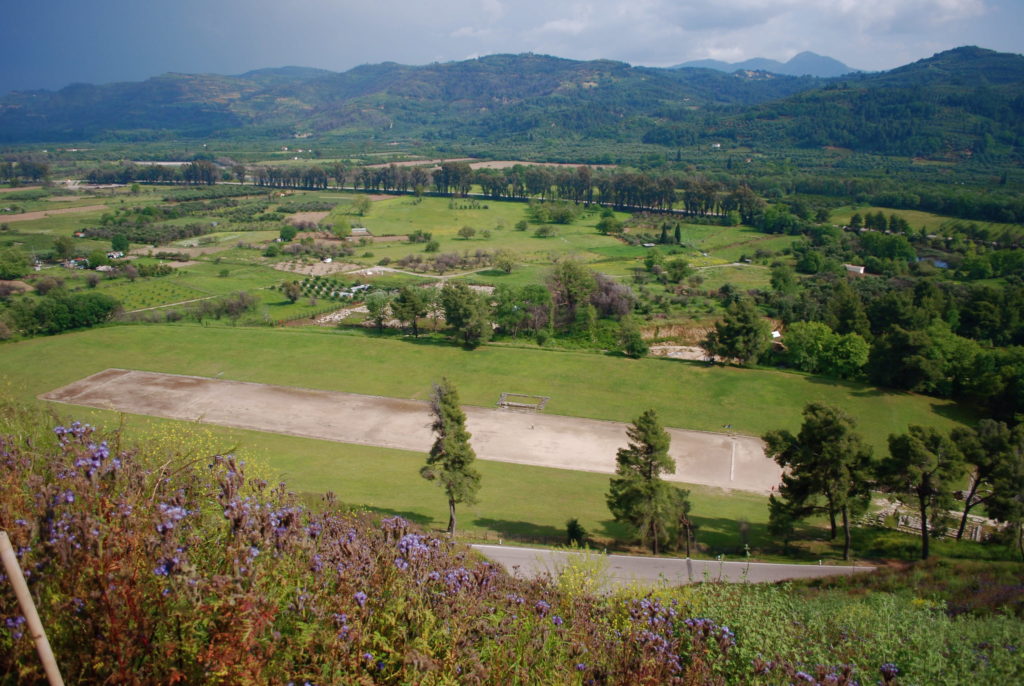
I also really like the food in Greece quite a lot. People really like Italian food, and I do too, but sometimes, especially on excavations, it’s mostly pizza and pasta. I know there is more to Italian food, but in terms of the food you get on projects the diversity that you get is much greater in Greece.
SCM: Yes! This is something that I often get into debates about with my colleagues who work in Italy. They are always arguing that Italian is so much better than Greek food, and I think the complete opposite!
MKK: Exactly!

SCM: I think people just don’t understand Greek food. All they ever order is souvlaki and salad. But there’s so much more; it’s such a rich cuisine, even if it’s not as famous for a bunch of expensive cured meats and cheeses and stuff. But the people who work in Italy are so chauvinistic about Italian food! Anyway, I am glad we agree!
MKK: On the Olympia project we usually had dinner all together, and I think in the entire five weeks we were there, there was only one time that we had the same meal. We ate at a great little taverna run by an older woman and man cooking in the kitchen, and they were making super traditional, old-school Greek food. And I think that’s what people mostly confuse: there is Greek tourist food and traditional Greek food, and the two are very different. So most tourists think that Greek food is mostly fried, but that is absolutely not the case at all. Like you said, the cuisine is really diverse internally and the spices are much more interesting than what we get in central Europe. I can definitively say that Greek good is far superior to Italian.

SCM: Preach! I agree with your earlier point about Italian food on excavations – my one project in Italy served us only meagre portions of pizza and pasta and it was totally boring and repetitive and we all felt kinda malnourished at the end because of the lack of protein.
In terms of the landscape and cultural environment, I guess I would say that of all the places to spend time in Greece, the modern town of Olympia is not necessarily my favorite. You know, in terms of a place to live. Probably most people would say the same about Porto Rafti – not exactly an idyllic traditional Greek village. But aside from that maybe Porto Rafti and Olympia don’t have too much in common – did you live in the nice secluded German house in the forest at Olympia? Or what was it like to live there amidst the cruise ship tourists for five weeks?
MKK: We actually could not live in the German excavation house, because it was too small for our group. Also, the excavation team lives there, and we were just the survey project! We stayed in one of the hotels in town, but it was really more like a hostel with shared rooms and bathrooms and that kind of thing. I’m pretty sure we got a special deal, so it was cheap for the project to put us in there for five weeks.
Olympia and Porto Rafti are both tourist areas or destinations, but Porto Rafti is a Greek destination, where people from Athens come for vacation, or just the weekend, but in Olympia you have tourists from all over the world. The town is just one big street with the hotels and the shops on it. Especially on the weekend and on Sunday when we had free time there were just buses everywhere because they were bringing in tourists and they were carrying out tourists…all day long! In the first year, we would walk around the street and everybody would bother us or ask us to eat at the restaurants, and we kept telling them that we weren’t tourists and ate somewhere else with the team. Then, after two weeks, the restaurant workers started recognizing us and stopped harassing us about eating at the restaurants, but we’d get into small conversations instead, like about the weather or whatever. And after three years we had developed these relationships with the people, like neighbors greeting each other every morning. So that was a very interesting experience, because we went from tourists and foreigners to something else. I enjoyed Olympia and staying there very much, but I definitely see that it is not the typical Greek village that you might stay in on a project!

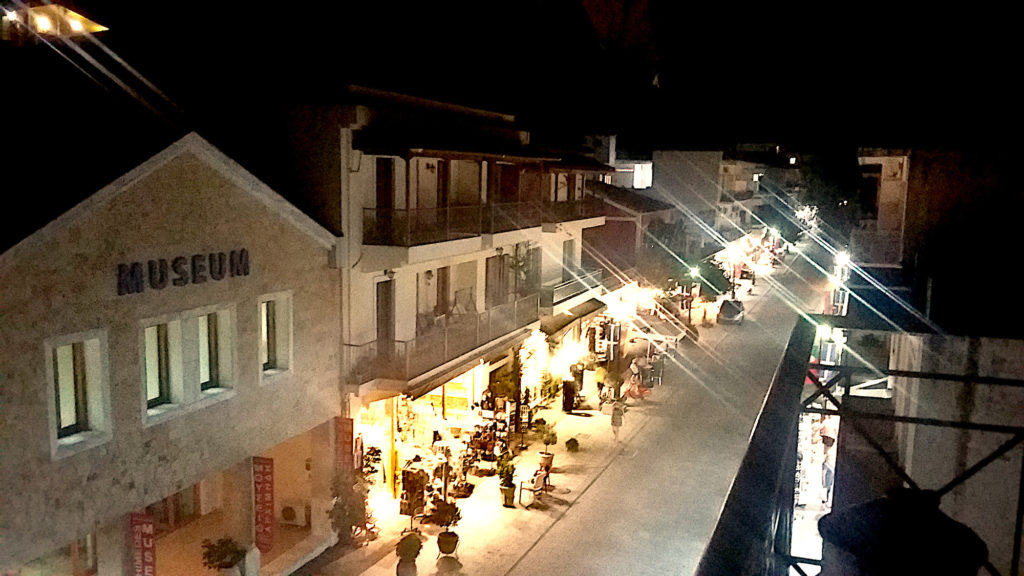
Porto Rafti is similar in the sense that you don’t have the village center with a church or a kafeneio or a bakery where you could sit around the whole day drinking a frappe and seeing the village life go by. The geographical layout of the town is even less conducive to that than Olympia, because the distribution of the houses is quite confusing; there doesn’t seem to be much of a logic to the town and everything is really spread out.
SCM: That is super cool about Olympia – that you and the team were able to delve behind the tourist façade and actually hang out with the people who live and work there on their own terms.
MKK: Yeah – for example, in the hotel where we were living a vase-painter was actually working out of the basement. He was basically our weather channel. Every morning we would ask him how the weather would be before we packed for work, and we’d take our raincoats or not based on what he said!

SCM: That is amazing! The basement craftsman/weather station. You’re right about Porto Rafti, too. I think it seems pretty clear that the people that come from Athens aren’t super interested in ‘the community’ so much as they want to go into their big concrete compounds and hang out alone in their beach houses. So, it’s definitely a bit of a challenging place to try to engage with a local community, whatever that would mean in an Athenian beach resort town. Anyway, let’s do one more question! How was your experience on the BEARS project overall – any impressions of the work or the people or strong memories that you want to share with the blog readers?
MKK: I really enjoyed the project a great deal! The people were wonderful, first of all, and I really enjoyed meeting the team and working with them. At first, I was not sure what to expect, in a way, since it was the first project I’ve worked on which was so international. At Olympia, we mostly spoke English because we also had Greek people working with us, but you always had your group of Germans where you could speak German if you wanted to. On BEARS of course most of the people were English speakers, which was a new situation for me. But I really enjoyed it, and everyone was really nice and friendly. In terms of the work, I definitely loved sailing to Raftis. I really like the sea, so going out in the boat was really lovely. Obviously the finds we had were incredible, on Raftis especially. Usually you just see stuff like that in a museum! To pick up things like that from the ground and hold them in my hands was so amazing.
Another thing that was interesting to me was the amount of digital technology that we were using, for instance collecting data on iPads. On my other projects we’ve always taken notes on paper and then had to spend a lot of time transferring the data to the computer. So it was interesting to see the purely digital recording method and to find how much time that opened up in the afternoons and evenings because of the absence of data entry.

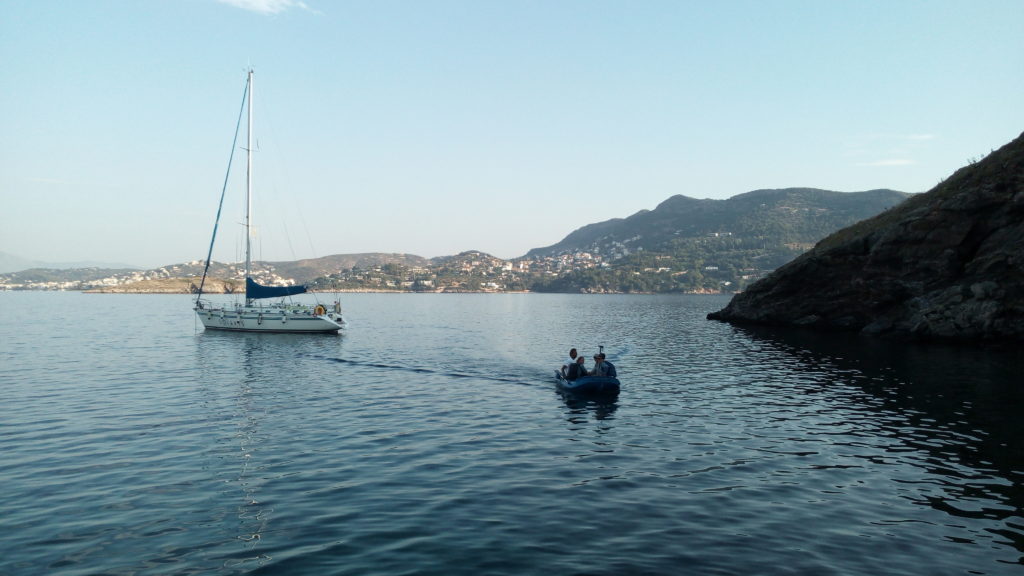
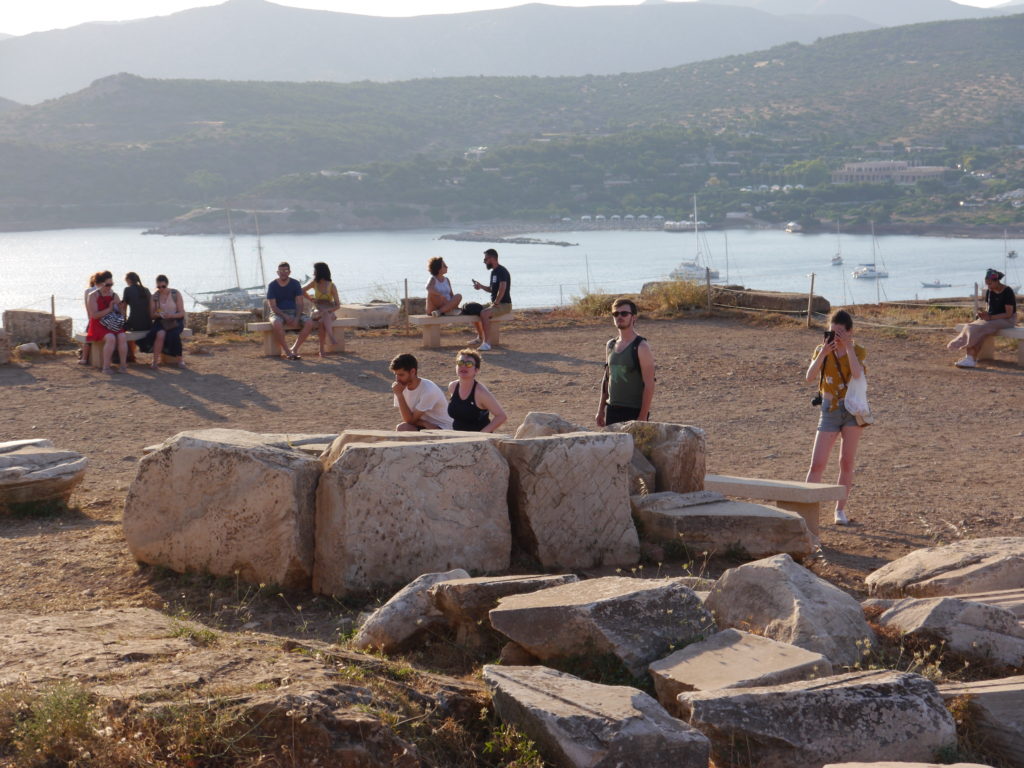
SCM: Yeah! It all worked out pretty well. I was kind of nervous about it, because a lot more can go wrong when you rely on technology, in a way. But I was super glad that we did not have to do any data entry! Which was always my least favorite part of fieldwork. And hopefully we’ll get you back out on the boat in future seasons, too. Speaking of the bright future, what are you most excited to get back to doing next time you are able to return to Greece for fieldwork?
MKK: Hmmmm. I would say the food! Just going to a nice fish taverna by the sea and sitting there in the evening after a long day of work…I really miss that feeling of enjoying a long evening at dinner and relaxing after a very tiring day of work. It’s not the kind of feeling you get in normal life, and it’s also never the same to have Greek food in Germany. You need the smell of the sea and the air and the sun and the particular ingredients. I am definitely looking forward to that.
SCM: Great answer! I look forward to such evenings in Porto Rafti sometime soon, too. Meanwhile enjoy your holiday preparations, and thanks again for taking the time to do this interview!
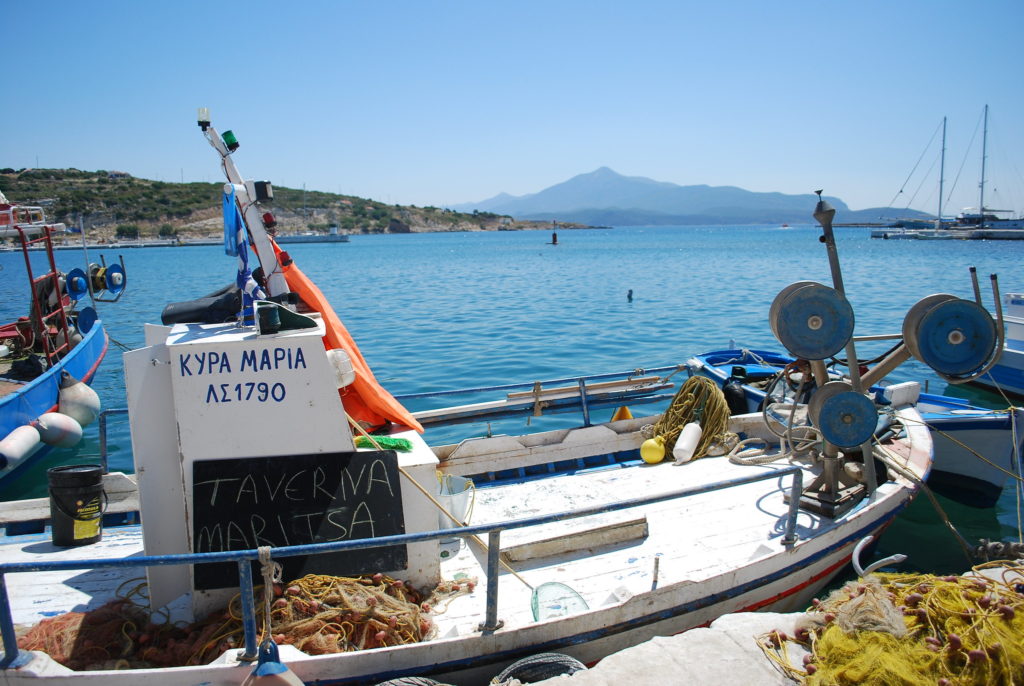
A Day Out on Raftis Island

Greece is a land of many islands, large and small, but is there any that is better than our own Raftis island? I think not. Maybe it is lacking in some categories of attraction, like the hottest clubs, sandy beaches, a bustling cultural scene, traditional yet commodious guesthouses, exquisite fish tavernas, etc. But what it lacks in mod cons, Raftis amply makes up with its unique rustic charm, retina-burning orange lichens, steep slopes covered in loose scree, and spiders of extraordinary size. Join us here at BEARS blog, if you will, on a guided tour of Raftis island, designed for the curious armchair traveler who is probably spending a lot of time sitting in front of a computer screen right now.
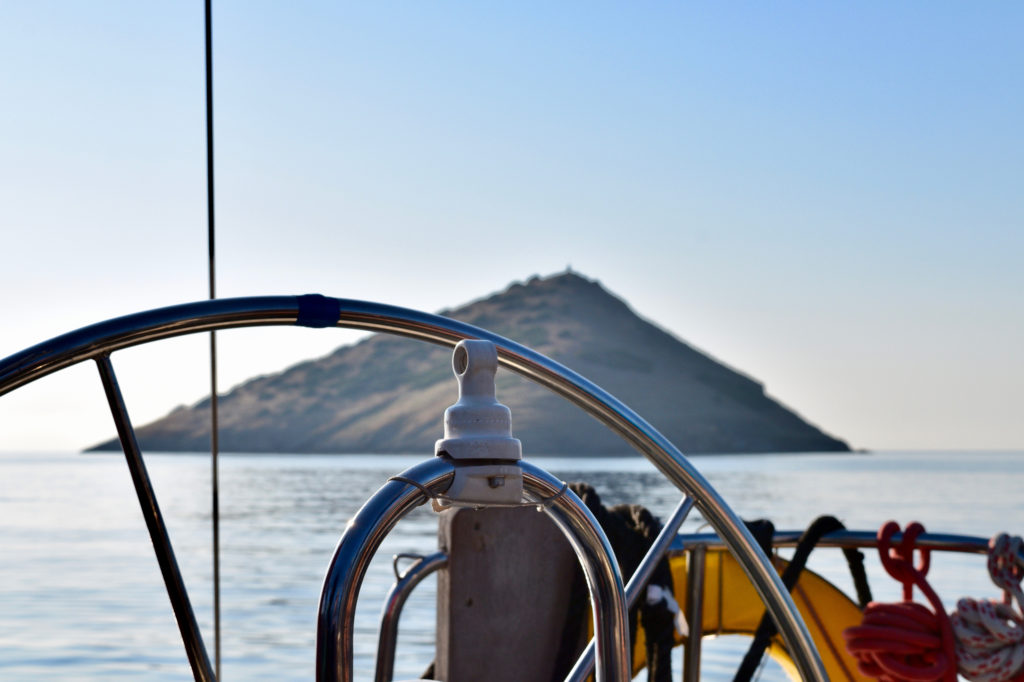
While some of the fancier islands in the Aegean feature advanced infrastructural improvements, such as airports and ferry terminals, for facilitating travelers’ arrival en masse, visitors to Raftis will need to reach the island through independent means. Usually we’d recommend a boat, but swimming is a possibility for the very physically fit and/or those short on cash. Either way, you’ll need to get permission from the harbour masters at the Porto Rafti port before you set off, since the island is a protected heritage site. Usually I have found that vacations do not benefit materially from time spent in the local jail, although sometimes a brief detention can serve as the basis of amusing cocktail party banter several years after the prison brawl bruises have healed.
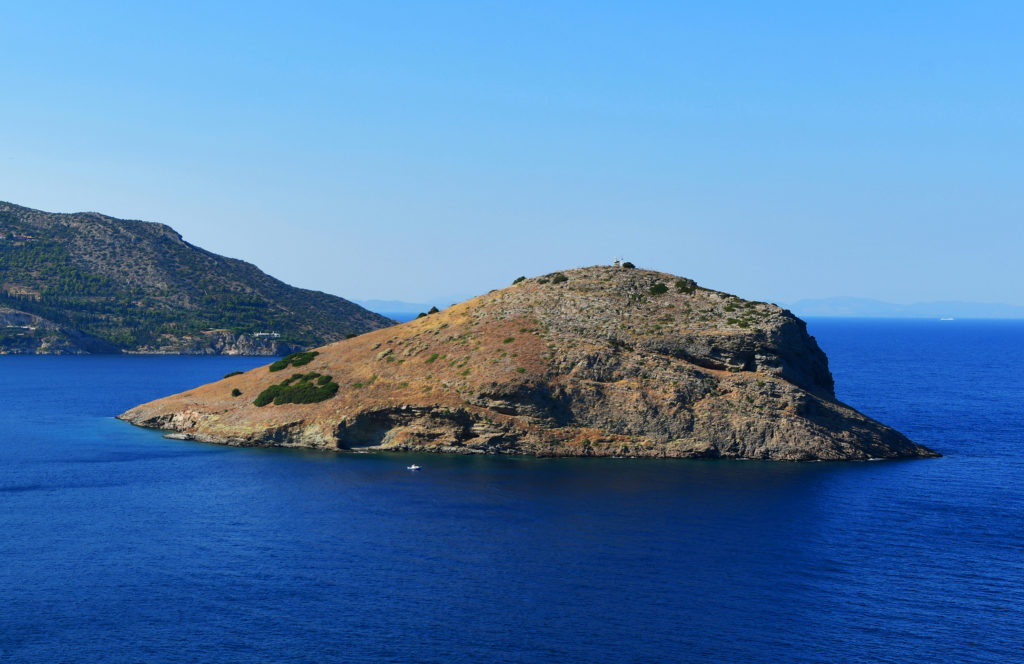
Your initial impressions of Raftis will vary with your chosen direction of attack. From the southern, Koroniward side, the approach provides stellar views of the dramatic cliffs and steep slopes that dominate the southern side of the island. There are often fishing boats parked off the island on this side, as I believe the shelter from northern winds and currents provided by its mass produces calm waters favored by local sea creatures. Either that or the fishermen think the cliffs look as cool as I do. The very steep slopes on the southwest part of the island seem like a terrible candidate for a rich archaeological context, but they are surprisingly covered in Mycenaean pottery. The caves in the cliffs further east are mostly full of bird droppings, on the other hand.
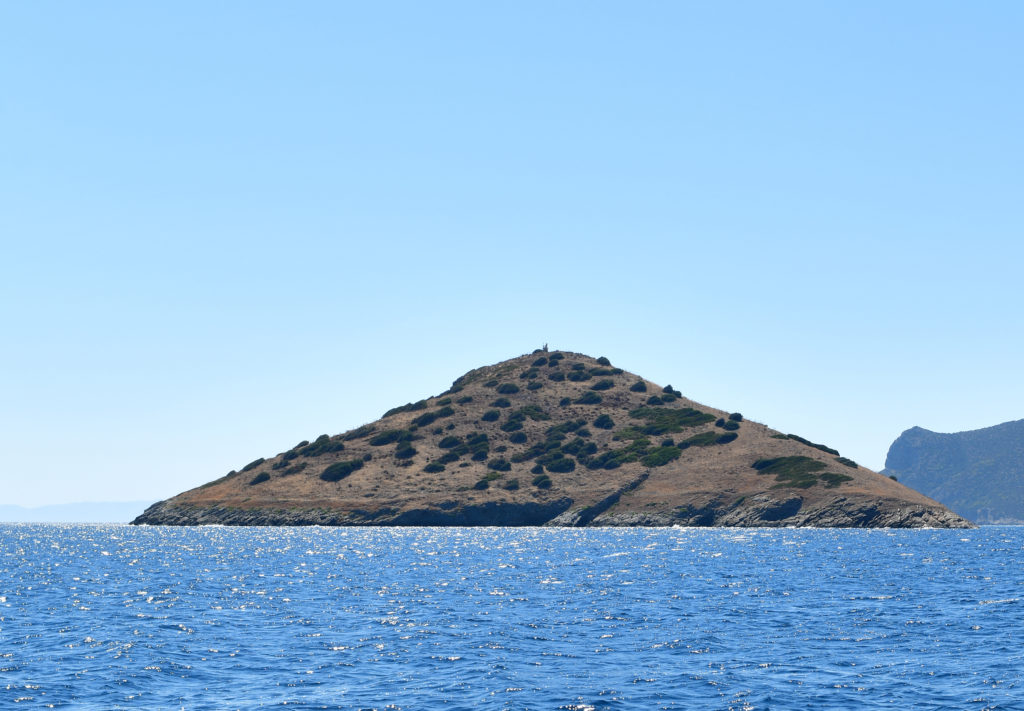
If you approach Raftis from either the west or the northwest, you will find the island to appear perfectly pyramidal in shape, even moreso than that other more famous “pyramid” island with an archaeological site on it. Though some have suggested that Raftis is too small and steep to have hosted a major settlement, there is plenty of architecture on those northern slopes! You can actually see the lumpen berm of soil that has accumulated behind the big circumvallating wall that marks the perimeter of the island in the photos above and below. It’s not exactly a monumental fortification or anything, and it may have served mainly as a terracing feature to prevent soil from the slopes from eroding into the sea. But it was certainly built by human hands.
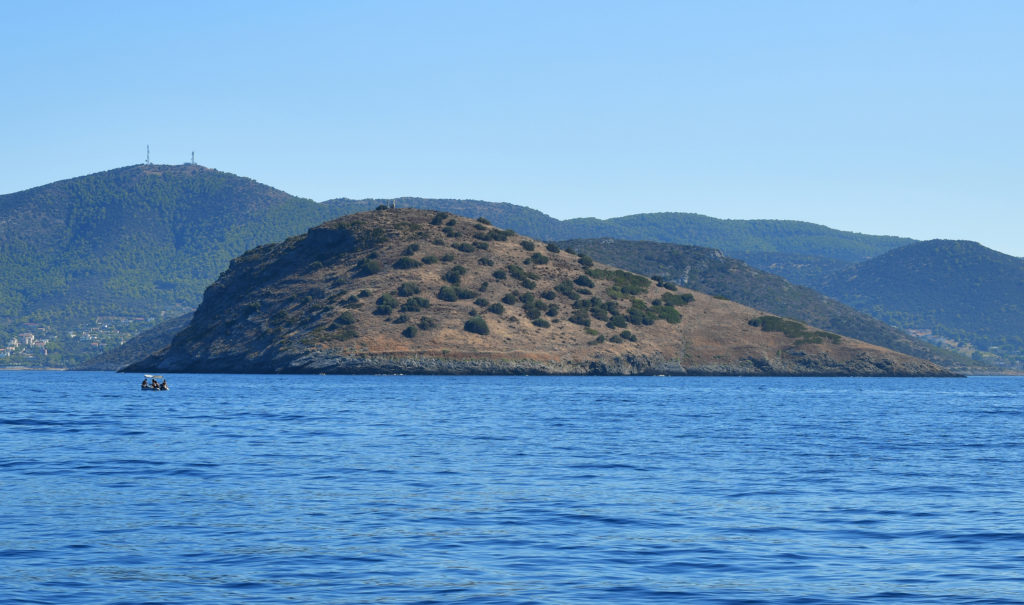

From the north Raftis looks more like a partially submerged horseshoe crab than like a pyramid, which is pretty cool, if you ask me. In the photo above you can see a little tourist pontoon boat full of swimmers who are probably thinking also about how much the island looks like a horseshoe crab.
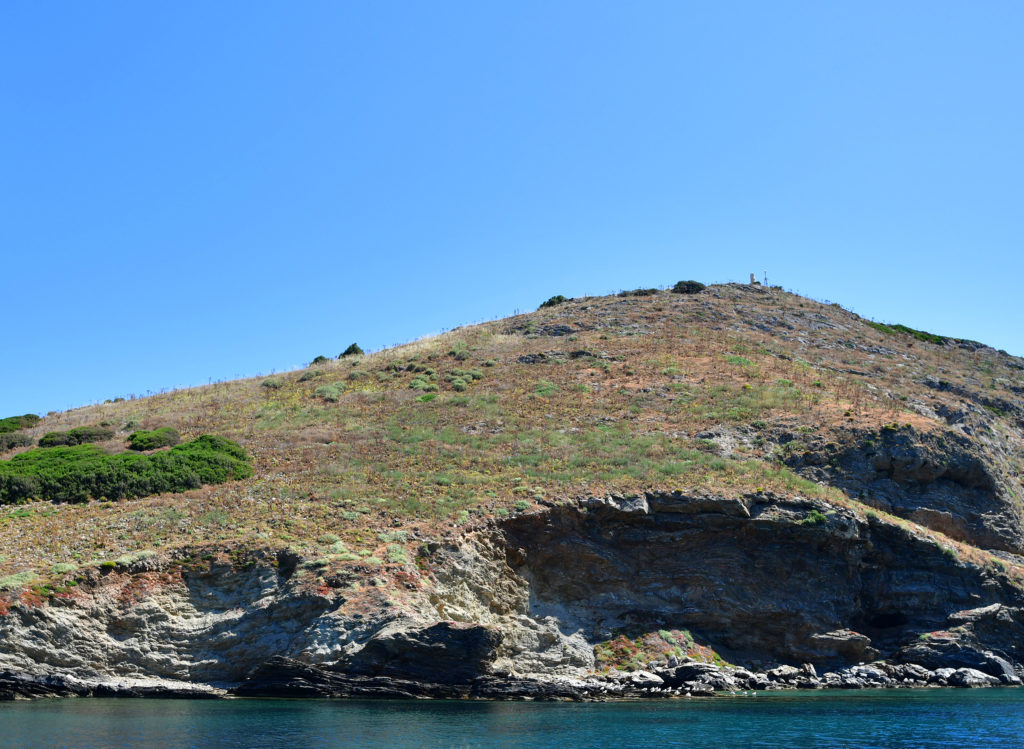
The coast of the island is not particularly stable, and the western and southern sides are characterized by small cliffs that appear to be the result of recent coastal collapse, as indicated by sizeable, fresh piles of rocks, dirt, pottery, and boulders below. The nature of these landforms may suggest that there were once easier approaches to the island from multiple directions, but as things stand now, the only really reasonably place to make a landing is a small cove on the western side of the island, just to the left of the fuzzy light green vegetation visible in the photo of the shore below. I’m not sure if there are more options for the swimmer, but someone with stronger aquatic skills might be able to check it out and let us know sometime!

Once a visitor alights on the island, there are a lot of excellent options for entertainment. The most popular of these is probably a bold ascent to the top of the “pyramid” in order to visit the island’s only permanent anthropomorphic inhabitant, the larger-than-life Raftis (tailor) statue after which the island gets its name.
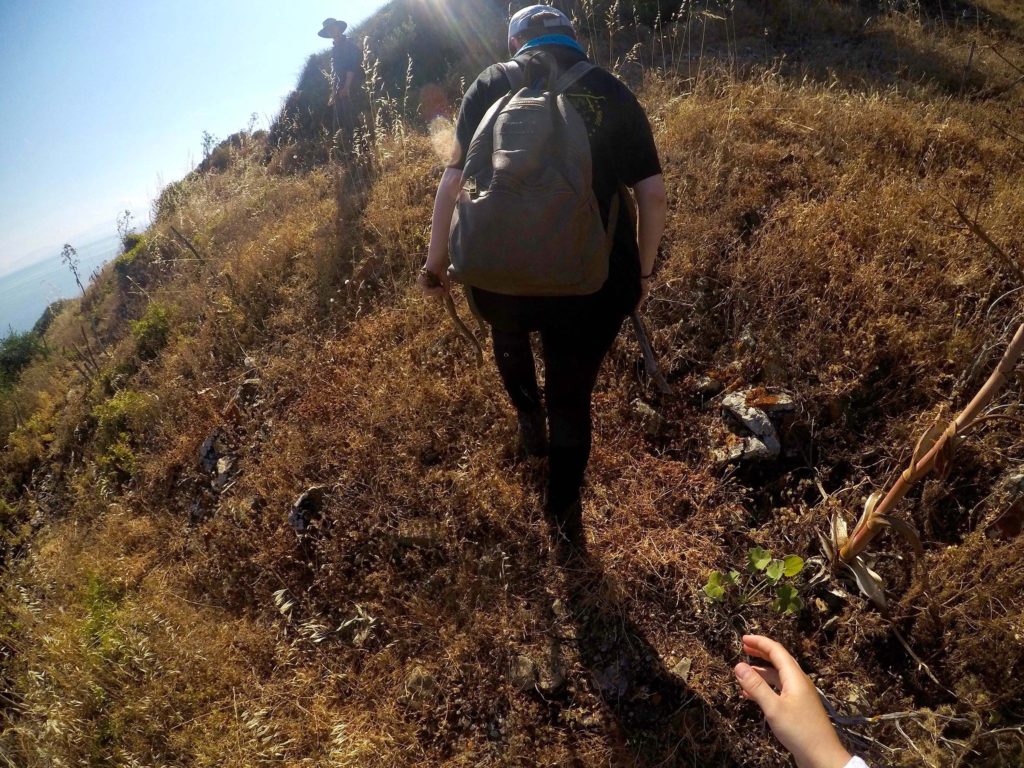
Depending on your capacity for clambering up steep slopes covered in loose stones and dense vegetation, the climb to the top only takes about 5–10 minutes. I’ve even seen it done in beach attire, so you need not worry about gearing up from the Orvis catalog in order to visit Mr. or Mrs. Raftis. Some visitors report the presence of a substantial population of supernaturally large spiders along the route, but visits throughout the year suggest that this is a seasonal issue. By August, when many Europeans take their island vacations, most of the fat, eight-legged Raftis residents seem to have died off or gone into hiding at their own alternative holiday destinations. Other faunal hazards include a number of fuzzy bunnies, a known nemesis to Greek hikers everywhere.
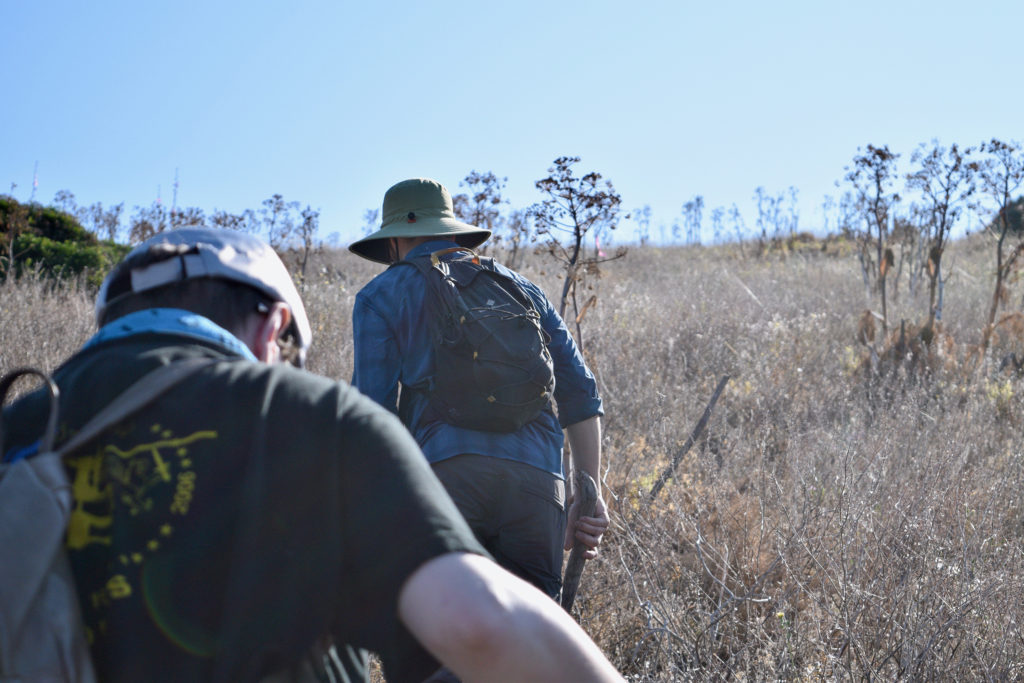
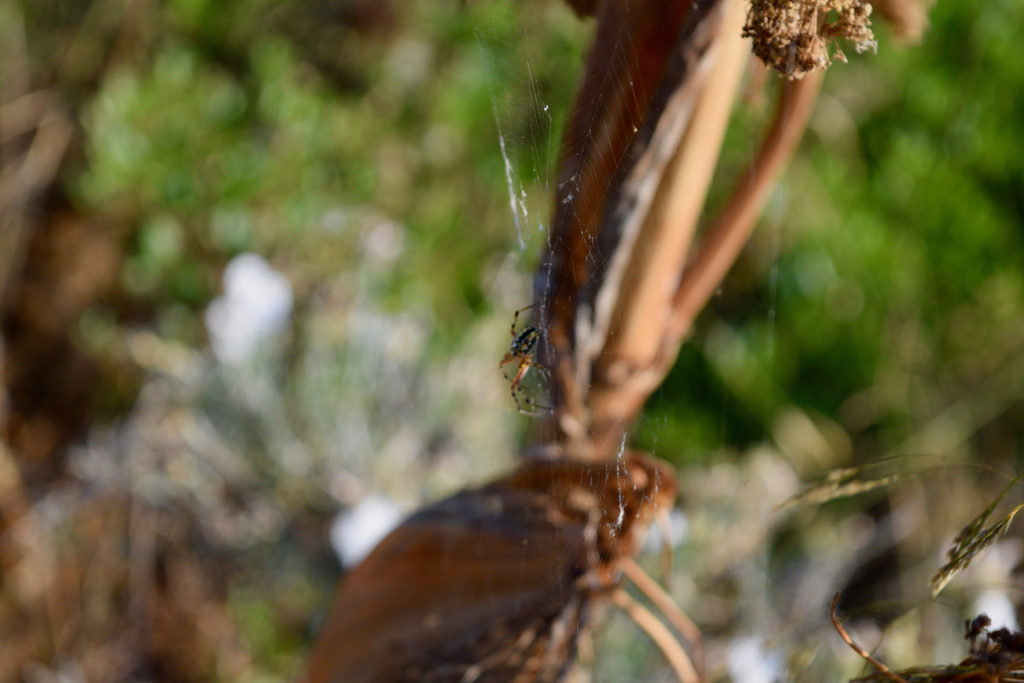
After a modest climb, a visitor will see the Raftis statue looming large on the horizon. Upon achieving the summit, a popular activity is to try to solve the great mystery of the Raftis with your traveling companions. For the ancient sculpture buff, this would involve guessing whether the statue was originally supposed to depict a male or a female, and/or deciding which god or goddess it might represent. If that doesn’t get your engine started, additional topics of controversy include: what the heck is this big Roman statue doing on a tiny island anyway? Who put it there and where did it originally come from? Who took its head, arms, and legs, and chopped the poor guy/gal up? What did he/she do to deserve such a treatment? Why is it called a Raftis? What would a Greek island vacation be without an opportunity to ponder such thrilling mysteries of history?
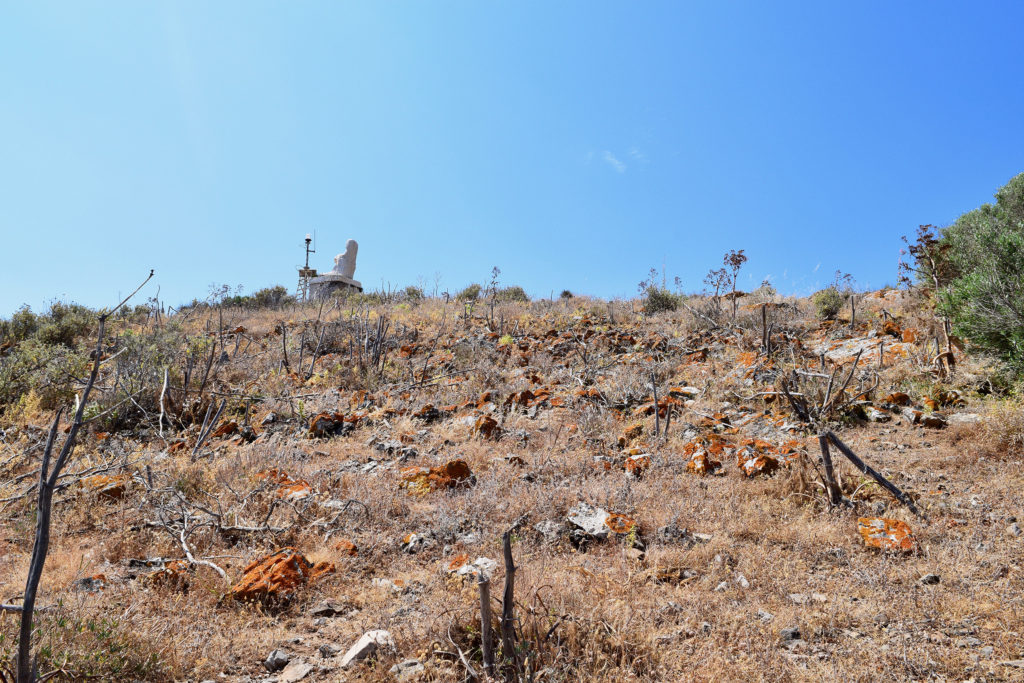
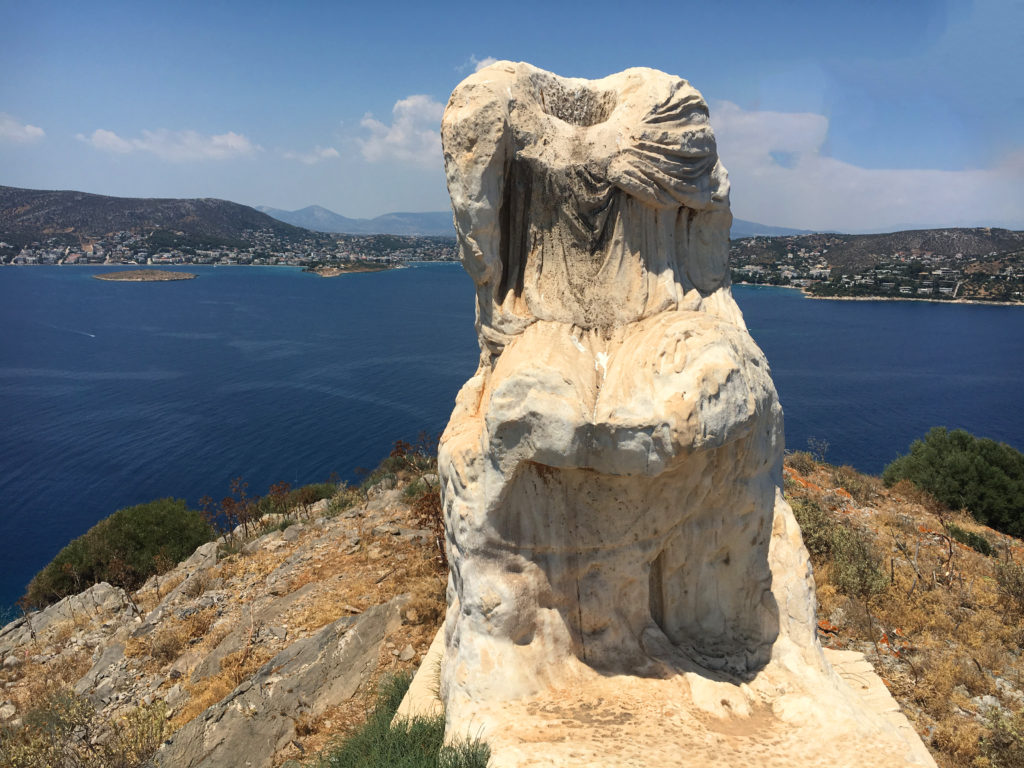
Once you’ve exhausted these debates, having gazed deep into the intellectual void within, why not take a moment to look outward and enjoy the view? To the north is a perfect coastal Aegean scene including the Perati mountain and Raftopoula in the foreground and Hymettos further afield, while to the east on a clear day the vista includes Mt Ochi on Euboea and several Aegean islands, including Makronisos and Tzia in the distance.
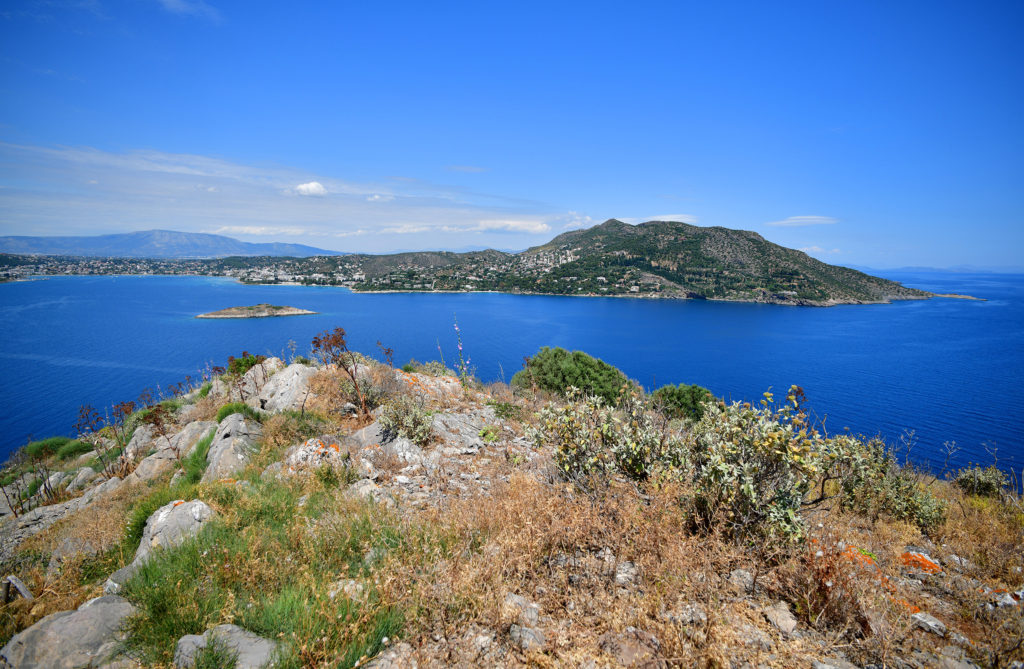
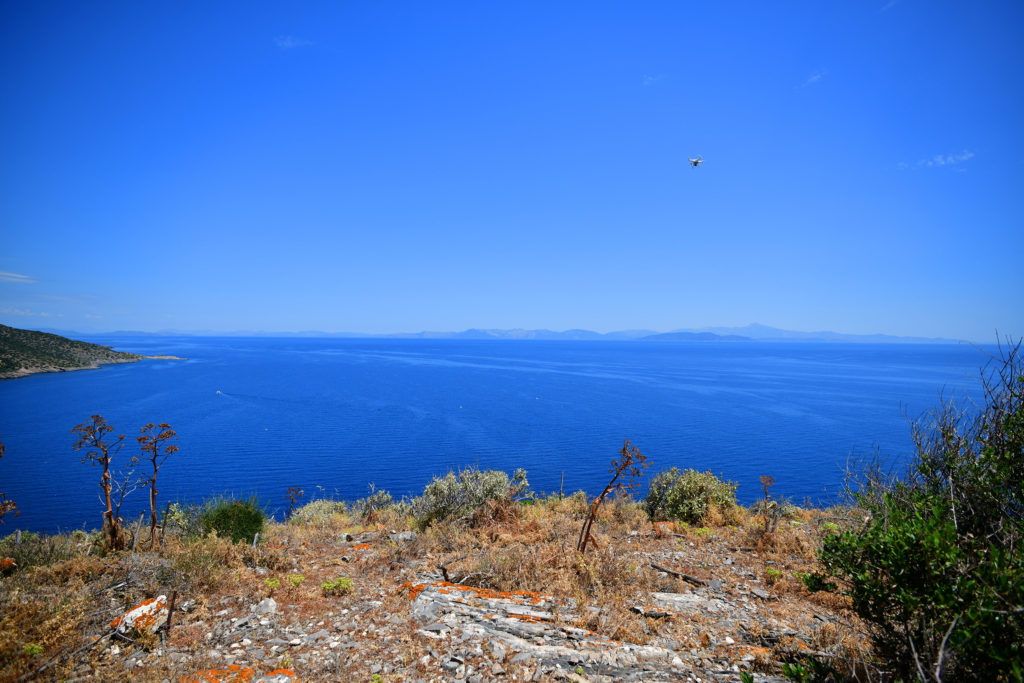
When it is hot outside, the area below the plinth of the statue provides a welcome place to take a break in the shade, and a motley assemblage of beer cans, cigarette butts, and snack wrappers suggests that many travelers have availed themselves of this option in recent years. On the BEARS project we rarely have time to indulge in such leisure activities, and when we do we surely do not leave our detritus around to provide any incriminating evidence. Instead, we pass most of our hours on the island wandering the slopes and staring intently at the ground, as you might expect of a group of dirty survey archaeologists spending so much time on a lump of territory that is pretty much covered in ancient pottery.

But wait, there’s more than just pottery on these slopes! Raftis offers opportunities for the amateur naturalist to appreciate the many different kinds of plants that flourish even in a relatively inhospitable Aegean maritime environment like this little windswept island. Wandering around the island, a person will encounter a variety of flowers that may or may not be in bloom, depending on the season. Summertime flora come June and July include various kinds of bindweed (aka convulvulacaea) and several flowering herbaceous sage species. In the springtime the island is thick with wild fennel plants and several kinds of asphodels, the spiny dead skeletons of which present an obstacle to thorough ground cover on our survey later in the summer, while at the same time helping us out by providing good places to tie the flags denoting the limits of our grid units. If you are planning to enjoy a fresh summer salad during your visit to the island, you’ll be sure to appreciate the presence of ample wild caper plants, especially noticeable on the steep southern slopes, where the wind can’t rip their delicate trailing stems all to shreds.

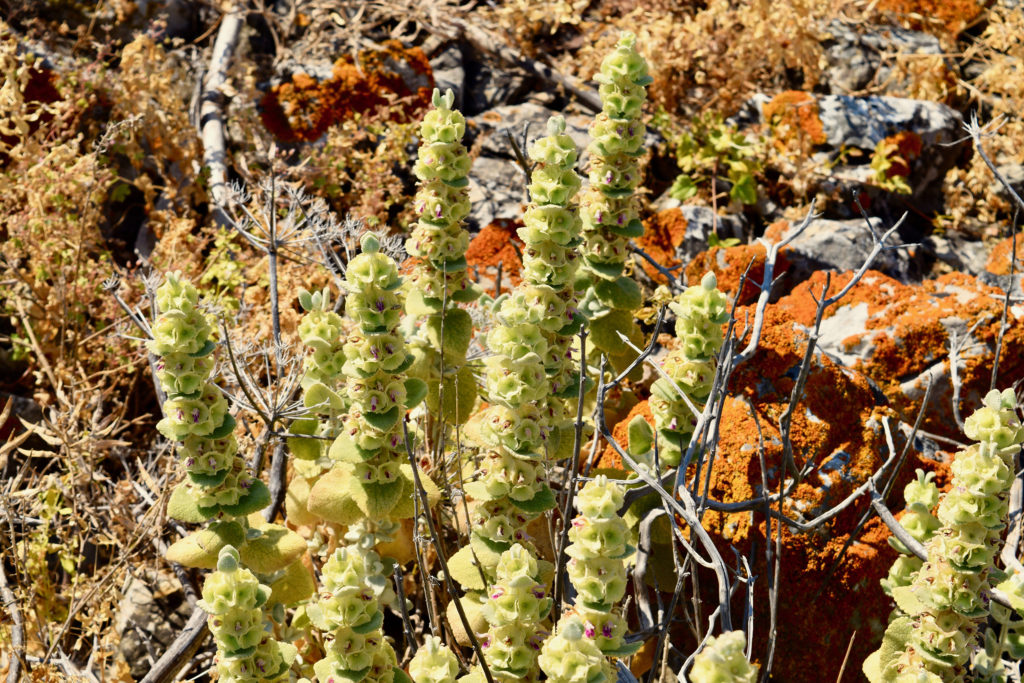
More substantial plant life exists in the form of small phrygana and wild olive trees and shrubberies that pepper the north and northwest slopes. These little trees seem to prefer growing over the remains of ancient buildings or structures, and thus hold many ancient secrets within. A lot of the best preserved finds from the survey on Raftis so far have been pulled from amongst the shelter of their roots.


Otherwise, in the summer you’ll most often be surrounded by tall, dead grasses during your visit, as Joey demonstrates here.
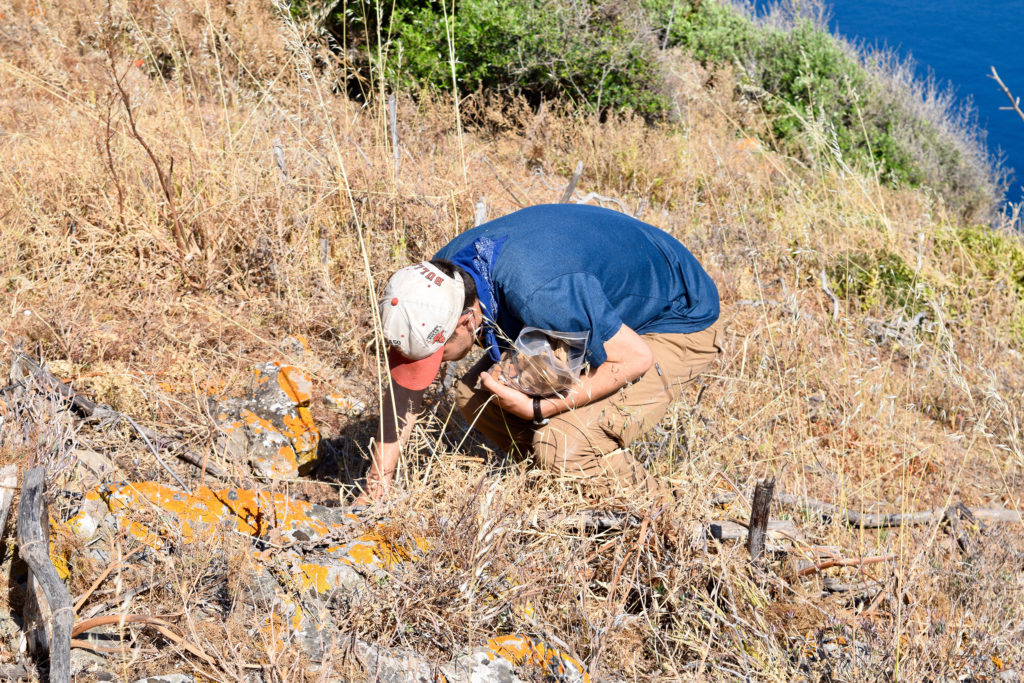
Perhaps the most exciting and visually pleasing natural feature of the island is the very bright crustose orange lichen that grows all over the rocks on the north slope. I refer to this stuff informally as Disco Lichen, but science tells me that it’s actually called Orange Sea Lichen (Caloplaca marina). Even some of our artifactual finds from this sector of Raftis are covered in fluorescent dayglo Disco Lichen, which is pretty fun, you have to admit. Eat your heart out, clubs of Mykonos!
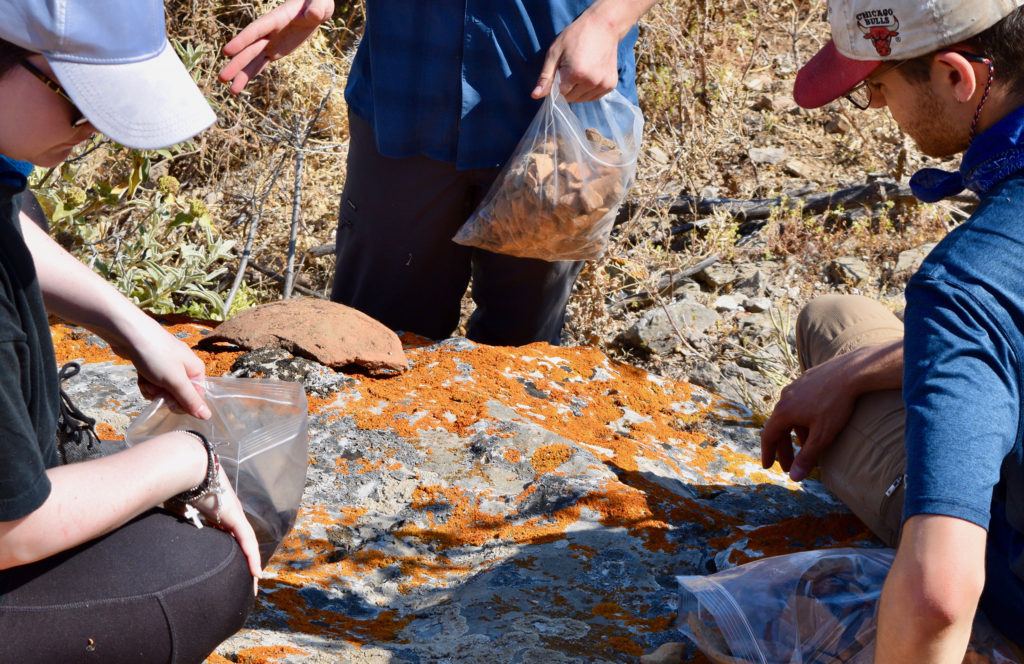
Once you’ve seen Disco Lichen, you’ll probably be too emotionally exhausted to press onward with any more excitement for the day, and this would be the time to descend back down the slope, through the dead fennel stalks and windblown grasses, to your means of conveyance. As you voyage across the bay to return to the mainland once again, I recommend reflecting upon the successes and failures of your life, and the way that your visit to the majestic Land of Raftis really puts all of that petty stuff into perspective.
This concludes our virtual tour of a day out on Raftis island. As you’ll no doubt agree by this point, Raftis really has it all! Just remember when it’s hitting the European Travel Top Ten Lists – you heard it here first.
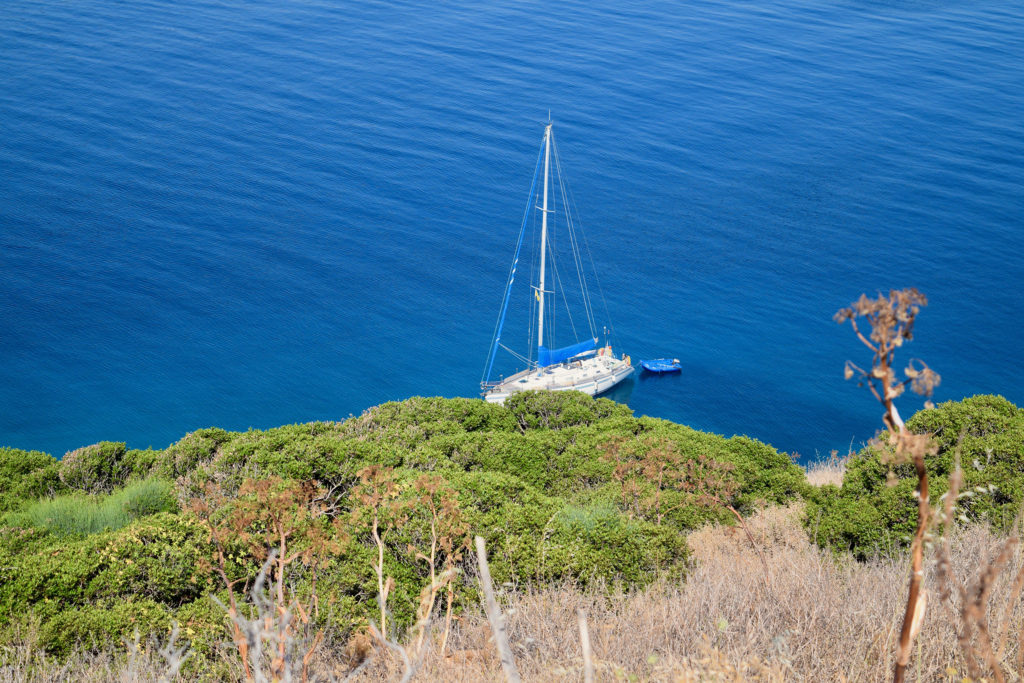
Hibernating BEARS
As winter descends in earnest and our team members look ahead to a long, dreary season of hunkering down at home (at least that seems to be the way things are heading here in Toronto), it seems like a good time (in line with what I hear is a major holiday down south of the border) to remember how lucky we are to have such a Number One Top Rated team of students and collaborators on the BEARS project, not to mention how fortunate we are to have the chance to work as archaeologists in Greece full stop. Whatever happens in the next couple of years, at least we’ll always have heaps of fun memories (and obsidian, and LH IIIC pottery, and data about rooftiles) from 2019.
For now, it seems like an opportune time to figure out how to actually hibernate for a few months. Someone wake us up in April when the snow melts and we’ll figure things out from there.

